

How To Cross the Atlantic, Routes and Timelines
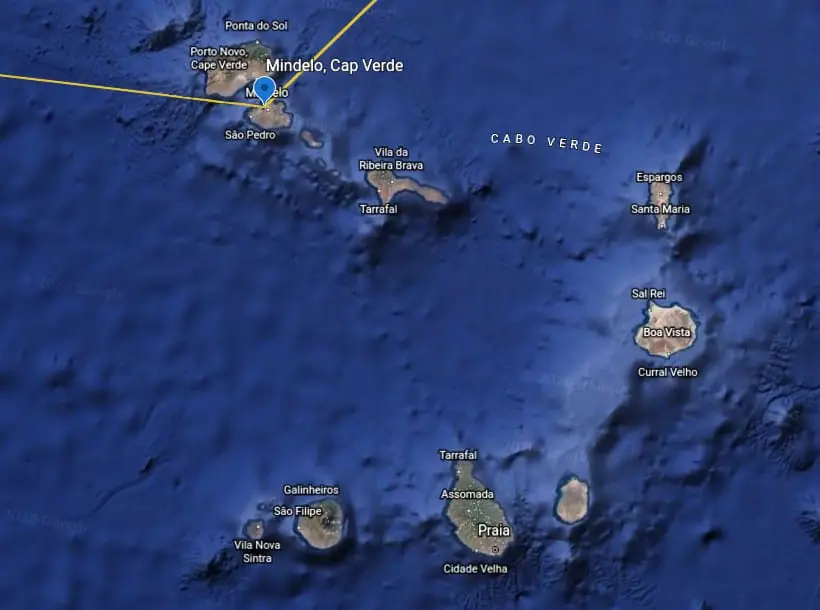
As an Amazon Associate, we earn from qualifying purchases. We may also earn commissions if you purchase products from other retailers after clicking on a link from our site.
Before the time of ocean liners and airplanes, crossing the Atlantic used to be a great adventure that took a long time to complete. Nowadays, it’s very different; it’s still a great adventure, but the time it takes to complete has changed.
Here’s how long it takes to cross the Atlantic on various types of boats.
Looking at this table we can clearly see that the time it takes to cross the Atlantic has decreased exponentially. Some big developments were of course the steam engine that allowed for bigger and much faster ships to travel the Atlantic while also bringing a lot more cargo.
If we look at the Sailboats in this list, we can see that the more hulls you have the faster it goes (if you want to know more about how that works, check out this article)
There is not a significant difference in time to complete between the catamarans and the trimarans in the short run, but in a circumnavigation of the world, the difference can be huge.
A monohull on the other hand is slower, this is mainly due to the amount of drag this type of hull has.
This table compares different types of boats under the same conditions and adds an airplane as a point of reference.
Transatlantic Crossing in Record Time
Here are the records for the fastest crossings of the Atlantic in a Sailboat.
The 2880 Nautical miles(5330 Km) long route starts at Ambrose Light in New York and finishes on an imaginary line between Lizard Point and Ushant of the coast of England
As you might have noticed, there aren’t any numbers for catamarans since the classes are divided between monohulls and multihulls. Since trimarans (three hulls) are faster than catamarans (two hulls), there is no real point in racing a cat.
What you also may have noticed are the ridiculously high speeds these boats are doing. Bear in mind that these are racing boats optimized for speed and made to smash world records.
There’s a big difference between the 28 knots a racing trimaran will make and the 9 knots a cruising catamaran will.
What Type of Sailboat Do You Need To Cross The Atlantic?
Crossing the Atlantic can be done in almost any sailboat or ship. As a matter of fact, it has already been done in small rowboats and open catamarans, so everything is possible.
If your question is what boat should I use to get a somewhat comfortable and safe trip, well, then we have something to talk about.
Choosing between a monohull or a multihull has more to do with personal preferences. Some people really like the stable platform of a catamaran, and others dont think it’s a real way of sailing and wants to be heeling over to its side to fully get that true sailing experience.
For me? Catamaran every day, speed, and comfort, but I’m also not a purist sailor in any way. I’m an adventurist, and the boat is merely a way to experience adventures.
The size I would say matters, bigger usually means it’s safer and can handle bigger waves, although it might be harder to handle on your own I something happens to you or your crew mid-sea.
Most people seem to cross the Atlantic with a boat in the 35 -45 ft spectrum, which fulfills both requirements!
If you are interested in digging deeper into what sized boat you should get, check out my article on Best Sized Catamaran for Ocean Sailin g
Other aspects you might consider are the size in terms of space onboard , how many people are you doing the passage with, the more people, the easier operating the boat will be. This assumes you have a well-trained crew that you know well.
And what are you going to do once you get there, is it the end of your trip or is the beginning. If you’re doing everything just to cross the ocean and then get someone else to bring it back, that’s one thing. But if its the start of a long adventure, the requirements are different. You are going to want more space for scuba gear, and other toys.
I do think the most important aspect is that you have a seaworthy boat that it’s capable of withstanding weeks on end with sailing in many times rough conditions.
This means that your equipment spent has to be the most expensive and handy, but it needs to be in good condition, and you need to be able to handle your great in every weather.
What Gear Do You Need to Cross the Atlantic?
Not including your average stuff when sailing, such as life vests, etc. There are some great that you might not be on your everyday say m still that could be of high importance during such a formidable sail as this.
- Emergency food
- Satellite coms
- Storm drogue (want to know what it is and how it works, read this)
- Spare parts(tiller, sails, etc.)
- Entertainment
Different Routes to Cross the Atlantic
Westward route: europe to the caribbean.
According to Jimmy Cornell, a well-known sailor and circumnavigator that has made his own research on the subject, Las Palmas is one of the biggest ports of departure for sailboats crossing the Atlantic.
Around 75’% of the sailboats that arrive in Las Palmas on the Canary Islands will depart for an Ocean crossing.
Getting to The Canary Islands, you should not be in a hurry; there are many very beautiful places en route. No matter where you are coming from this is a good stop well worth a visit.
Coming from the north of Europe, you have France, Spain, and Portugal. Entering from the Mediterranean, you have Italy, Croatia, Greece, and so many other interesting places that you shouldn’t miss unless you’re on a very tight schedule.
Once you reach Las Palmas, you can either go straight towards the Caribbean island of Barbados, or you can do a stop along the way at Cap Verde.
Planing a Stop on Cape Verde
A stop at cap Verde makes sense in many ways; for one, it makes the transatlantic trip more manageable by dividing it into two sections.
The second reason is that it gives you the possibility to stock up on fuel and water that you might have used more than you thought. Since Cap Verde is well developed when it comes to receiving boats doing this type of passage, there is no technical expertise on the island.
From Cap Verde, you can also take a direct flight to Portugal and onwards if the need arises.
Even though you might not plan to stop here, the recommendation is to at least plan your sailing, so you pass close to the islands, so if something happens, you can head to Mindelo port and fix it.
Another good reason why you would go close is that the further south you go, the better chance you will have of catching those sweet tradewinds that will take you safely and enjoyably to the warm waters of the Caribbean.
Westbound Route On a Catamaran
Sailing west is the preferred option for any sailor and especially if you are on a boat that doesn’t sail perfectly upwind, such as a catamaran.
Sailin g west and using the tradewinds is perfect on a catamaran, the sail will be faster and more comfortable than a monohull of the same size.
Looking at the 2019 ARC (Atlantic Rally for Cruisers), a 55ft french catamaran outclassed the 65 ft professionally sailed monohull with a 10-hour lead. All this while doing yoga on board, something that I can promise was not happening on the monohull.
The stable platform of a catamaran with the wind on your stern makes sailing west on a transatlantic passage perfect for Catamaran.
Eastbound Route: The Caribbean to Europe
Coming back to Europe, I would argue that the same principles are still valid: to stop at or pass by islands close enough to have the option of going into port if need, and using the tradewinds to your advantage.
Considering this, most people leave the Caribbean from Tortola, Britsh virgin islands, or St Marteen. These make great starting points for the eastward journey since they are the last point where there is plenty of fuel, spare parts, and food for the long and sometimes arduous trip back to Europe.
Though it is not necessary, many sailors make a halt at Bermuda; this is a good start to fix anything broken or wait for the right weather before your head on to the next part of your trip.
The Azores, the same goes here, you can skip it, but staying close to it adds safety and comfort if needed, and I would also stop by just to enjoy the islands. It’s a beautiful place and good for a few days of low-intensity cruising.
If you still have some energy left after the trip from Bermuda, one option is to head for a place called Horta. The place is well remembered for its hospitality towards sailors heading towards Europe.
Once you have refueled on diesel and energy, it is time to head for northern Europe. This is usually done by sailing north until the 45th latitude and then heading east.
When is The Best Time to Cross The Atlantic
Choosing a route has a lot to do with your intended purpose of the trip, are you going for a speed record, then going more north might be an option, and accepting the risk might be ok for you and your crew.
If you are going west but more interested in doing it safely and are able to spend a little more time out at sea, then the southern routes mentioned above with a departure date around November and December.
Going west on your way to the Caribbean, you’ll notice the days are getting warmer and longer; this is because going west, you also travel south towards the equator where the days and nights are equally as long be it summer or winter.
This weather window is to avoid the hurricane season in the Caribbean that ends in late November, these are the main risk and must be considered in your plan.
What Is The Best Route For an Atlantic Crossing
Taking into consideration the information above with trade winds, the possibility of breakdowns, and the collective knowledge of the area.
The best route for a westbound Atlantic crossing is from Las Palmas (on the Island of Gran Canarias) to Barbados Via Cap Verde. The best route going east is from St Marteen to the Azores Via Bermuda.
This is, of course, based on the assumptions we have discussed above, and it might not apply to your skillset or aim of the crossing.
Can You Cross the Atlantic Single Handed?
You can definitely cross the Atlantic on your own (short-handed). As a matter of fact, many do every year. Of course, this demands more of the sailor since there is nobody to ask for advice or to help while underway.
Neither is there anyone that will help you with handling sails or maintenance while underway; because of this, it is more dangerous and more difficult to solo sailor sail short-handed as it is also called.
The usual way is to either bring a crew of your own, recruit a crew from the port of exit, or find one online via crewseeker.net.
Is Transatlantic Passages Dangerous?
Sailing in big oceans is never a hundred percent safe. This is why it is an adventure if it was absolutely safe, where would the attractiveness and the excitement lie?
Looking at the data, there aren’t many accidents happening, and of those, there are even fewer that are deadly or leave the crew injured for life.
There are also ways to make it safer; we have discussed boat size and crew skills; other route selection factors are vital. It might not be the quickest to cross the Atlantic, but the southern route seems to be a safer bet.
Prepare yourself, your crew, and the boat, and the chances for accidents will still be there, but they will be small and manageable.
How Lonely Is Crossing The Atlantic?
Spending two to three weeks in the middle of the ocean can definitely be lonely, but it can also be the absolute opposite. If you’re sailing with a crew, you will share the same small space with everyone else, always bumping your elbow. If the weather is rough, you may all be a little tired, which also adds to the group dynamics.
But even if you would get sick and tired of your crew, there are ways to call back home. You might have a Satellite phone, which is expensive by the minute but a lovely way to hear the voice of a loved one back at land. Much better than a text message through Email.
Sending emails has been a pretty straightforward process since the SSB radio started to be utilized. This type of radio is very simplistic and has good reception up to thousands of miles .
The nice thing with this radio is that it allows for data traffic, which means not only are you able to receive weather updates, but you can also contact your family through Email.
Can You Get Rescued If Something Goes Wrong?
Yes, there might not be a coast guard or anything nearby, and you might be way out to sea, but there is help to get. Since every ship is listening to some set of frequencies, usually, the first step is to call for a Mayday on that channel.
If you’re not getting anyone’s attention, then they might still see you on the AIS, Automatic Identification System, which makes anyone around you know where you are.
Many times the crossing is done together with a lot of other vessels; this gives comfort as they might also be able to help in case of emergency.
If all this fails, you probably also will have your EPIRB, Emergency Position Indicating Radio Beacon , which is a gadget that can be activated through certain triggers such as water, tilt angle, or manually activated.
Once activated, it sends an emergency signal at different frequencies and relays the information back to shore for someone to come help you.
Owner of CatamaranFreedom.com. A minimalist that has lived in a caravan in Sweden, 35ft Monohull in the Bahamas, and right now in his self-built Van. He just started the next adventure, to circumnavigate the world on a Catamaran!
Leave a Reply Cancel reply
Your email address will not be published. Required fields are marked *
Save my name and email in this browser for the next time I comment.
Recent Posts
Must-Have Boat Gear for Catamaran Sailors!
Sailing is probably the most gear-intensive activity I've ever done; there are so many decisions to be made about what gear to buy now, for tomorrow, and what to definitely never buy. The gear on...
6 Best Trailerable Trimarans For Bluewater and Coastal Sailing
Having a boat costs a lot of money, even when you are not using it, marina fees, etc. And once it is in the water most sailors never go very far from their "home marina" and sailing will be somewhat...

Travel Across the Atlantic by Sailboat | 10 tips for a happy and safe ocean adventure

Travelling an Atlantic Crossing on someone else’s sailing boat is not a straightforward endeavour and an adventure to be taken lightly. Finding a boat is one thing, finding the right boat, crew and captain match is what makes all the difference. There are some things to be mindful of.
Almost everyday we receive a message from someone who would like to sail across the Atlantic ocean as crew. We’ve created blogs, a book , resources , local provision contact, a story collection, and an active network you can tap into to make the Atlantic sailing dream real.
And there’s more coming! We’re stepping up our game to help you get out there! Join the ‘ Sailing across the Atlantic’ theme month this August on our member network. We also have an online sailboat travel & lifestyle crew course in the making to guide you on this adventure. And last but not least, this year for the first time we also organize a voyage across the Atlantic ocean that you can join !
Join the conversation this August about sailing the Atlantic. Many of our members have done it, and many are looking to do so.
Perhaps the ocean nomads adventure to sail across the Atlantic that we organize doesn’t fit your timeline or budget. So here are some more waypoints to get you across the ocean, happy safe and meaningful. Above all, we like to make ocean adventure accessible, and memorable and impactful.
Five times our Suzy has sailed as crew across the Atlantic. In fact, she hitchhiked on +50 sailboats across the world. So many lessons learned. Here are a few of her tips to get your Atlantic sailing journey started. + Find dozens more tips and stories from Ocean Nomads network members who sailed across and shared their lessons learned on the network.
Ten tips for crew looking to sail across the Atlantic Ocean.
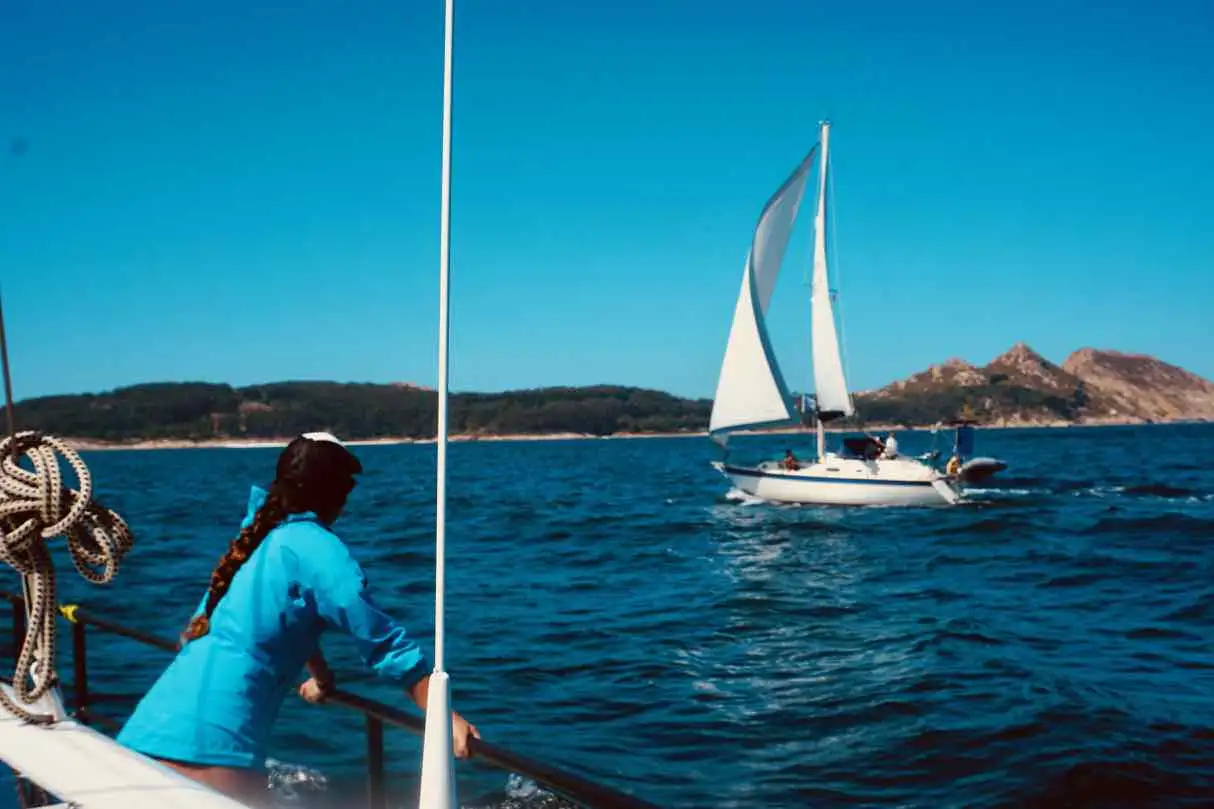
1. Have your WHY clear
Do you want to gain sailing experience? Learn as much as you can about seamanship? Go from from A to B and reach a certain destination travelling by sail? Meet sailors living on sailboat to learn from? Just be away from all of it? Or simply chillax on anchor in pretty bays? Search accordingly. There is a huge variety of sailing vessels and styles of which only some will match what you’re looking for.
Share what you are looking for in the Ocean Nomads network and our community captains create personalized connections to people and resources that can help you further.
2. Be Confident or Start small
Be confident you’re ready for an ocean passage. You owe it to yourself, captain, and fellow crew. If you’re not sure about the full Atlantic Crossing, start with a trip near shore or a shorter offshore passage to figure out if an ocean passage is for you.
The upcoming autumn / winter we facilitate numerous offshore voyages shorter than an ocean crossing but long enough to dip your toes into offshore sailing and learn if it’s for you. Sail with us from the Netherlands to Madeira . Sail with us from Madeira to the Canary Islands. Or from Sail with us from the Azores to the Netherlands. Or jump on board with one of our 70 vessel members .
The voyages we organize are the fastest way we can facilitate a new heading in your life . Literally ;). You get to meet, live, sail with fellow ambitious ocean lovers and be introduced to ocean travel through experiencing it yourself. And all the connections, learnings, and next opportunities that come with it. Paula, Nadiem, Thomas, Pim, Sael, Anna, are a few of our example members we’re so proud of who joined us on a trip as one of their, if not their first sailing experiences, and then made their Atlantic Sailing dream happen .

3. Know the bearings
To be ready to expect the unexpected, careful investigation and preparation is essential for a happy and safe ocean passage. Learn about the Atlantic Ocean passage, seasons, distance, destinations, weather, costs, and tasks involved. This will help you find a ride at the right time and place.
Explore the ‘ Sailing across the Atlantic as Crew ‘ resource on our member hub for the basic bearings, ask your questions, and we do our best to pin point you in the right direction. This August 2022 we have our theme month about sailing across the Atlantic on our member hub. Join in to get ready for the Atlantic crossing.

Map of Atlantic Crossing Sailing Routes
4. Be flexible with time, place and money
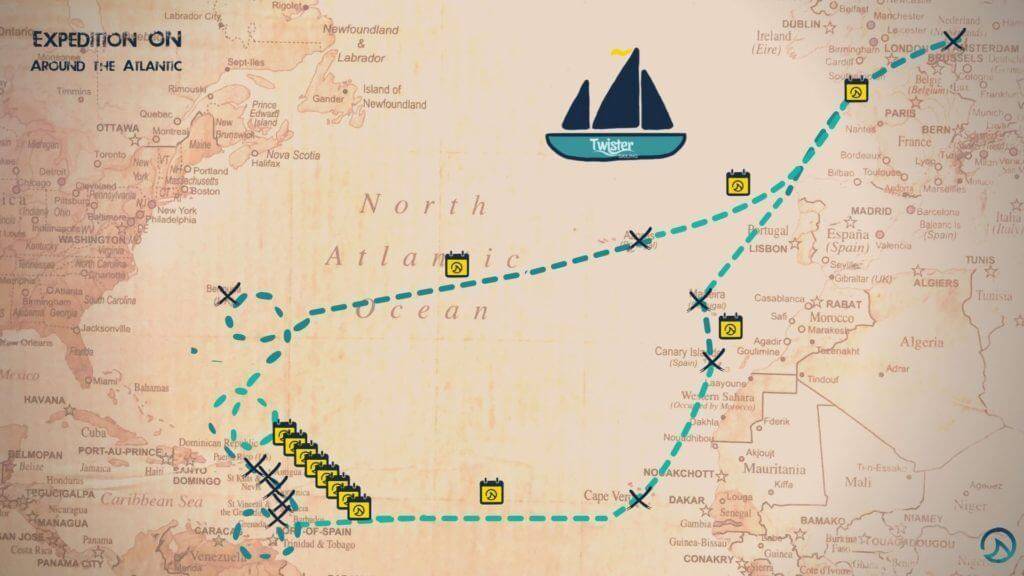
Sailboats deal with seasons, routes, weather, breakage, and all sorts of variables. By thinking about scenarios in advance makes it easy to peacefully change course and comply with Captains’ calls.
That said, upcoming winter 2022 / 2023 we organize an expedition with Ocean Nomads across the Atlantic. The professionalism and nature of the collaborative vessel (+100 year old schooner!) allows for a certain schedule, as well as a beautiful space to unite a selected crew of impact driven ocean adventurers. Accelerate your Atlantic ocean sailing dream. Apply now to join !
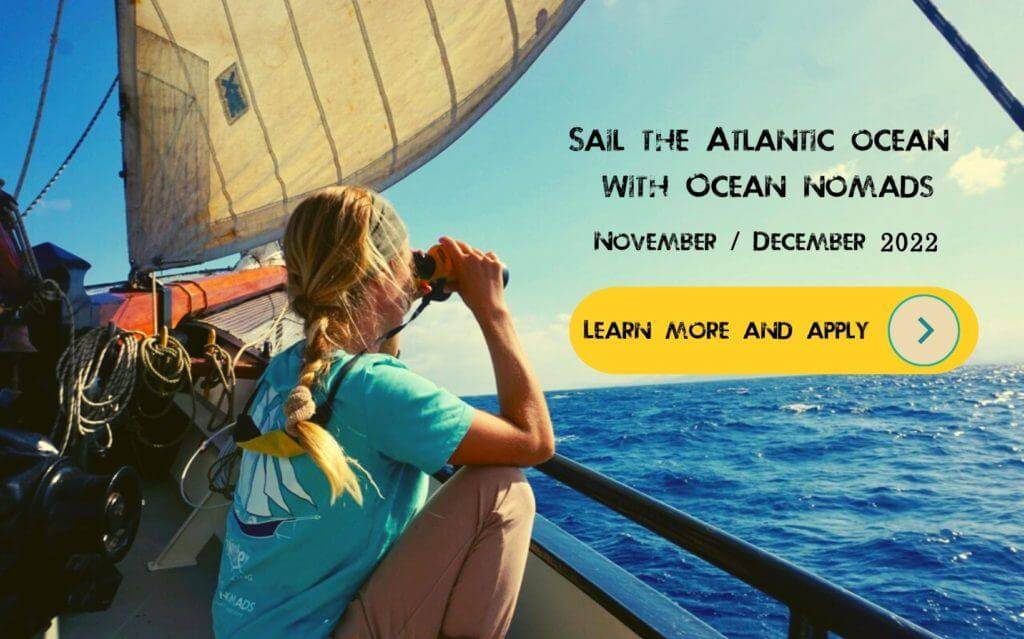
5. Be 100 percent happy and confident on with whom you’re jumping on board
We’ve met too many people that thought to ‘just’ hop on a boat do an Atlantic Crossing. Unsurprisingly many of them did not succeed in having a pleasant experience. And that’s a pity. Because it should be a beautiful memorable experience to never forget. On the Atlantic ocean, you live, work, eat, leisure together for weeks. Non-stop. It’s like camping in the wild with a bunch of strangers. Only you can’t walk away… Inform yourself, research and prepare. It’s part of the fun! And essential for feeling and being as safe as you can.
Research the boat, captain, and crew carefully. The people you share the adventure with either make or break the experience. Realise that anyone can buy a boat without experience or license. Exchange loads of messages, ask questions, and talk to each other on the phone, preferably with video. Meet-up, fix things together and go for a test sail. Don’t let your eagerness to make a trip override your instinct and judgment. Be 100 percent sure and clear about expectations and intentions.
And network! Sailing the Atlantic is a big deal and big dream for many captains and boatowners. They would like to undertake this adventure with people they feel good with, people they know, or are referred to by others. We for example have one member, Wolfgang, who is now already selecting crew from the Ocean Nomads network for next year. Also we have a few Atlantic sailing crew opportunities for this year! He takes the time to get to know the potential crew. Have a foot in the door early so your chances are increased to be welcome on board.
Find a safety and happiness assessment checklist and questions list in book Ocean Nomad and in our upcoming Sailing Across the Atlantic theme-month on our member hub.

Ocean Nomads Crew
We learned that at the end it’s all about the people you share the experience with. That’s a big reason we started Ocean Nomads , to connect more of the adventurous and conscious minded ocean explorers to each other. We have had more and more boat owners particularly reach out to Ocean Nomads because of the amount of ‘noise’ and unmatching crew requests via the many Facebook groups and crew websites. Ocean Nomads members are seen as serious and well-informed crew members. We want you to spent the least amount of time online ‘(re)searching and the most time adventuring out there!
Throughout our expeditions we walk the extra mile to bring together a unique mix of inspirational individuals talents and knowledge on board. We release the power from the individual talents and knowledge into the group, for maximum learning experience. We select participants based on motivation, drive, and mindset. For legs of longer than 10 days we additionally interview on the phone to make sure expectations, mindset, and values are aligned.
“Expedition ON gave me everything I was looking for. It has opened up so many possibilities to meet new people with similar vibes, including connection, companionship, purpose and being one with nature.” – Cay Chandler Netherlands – Canary Islands ‘21
6. Feel and Be Safe
The ocean deserves our greatest respect. Sailing remotely is an endeavour not to be taken lightly. Especially when joining a smaller sailing vessel, when assessing the options and figuring out if a boat is a good match, talk to the captain, learn about the vessel, the miles sailed on the vessel, and other crew joining. Don’t let your eagerness to make the trip override your investigative spirit, instinct and judgement. Discover the strengths, weaknesses and interests of the captain, crew and boat. Put your critical hat on and do your homework. It’s not ‘just’ a ride.
ON expedition ON with Schooner Twister we prioritize safety. Teaming up with Twister allows us to combine professionalism, safety, and adventure, impact and community facilitation. After three offshore collaborations, the only thing we broke were 2 plates. Many certificates are obtained and complied with to pass the safety checks and requirements to take people out offshore. This comes with a cost but the rewards are priceless. Offshore we keep contact and update relatives about the trip (Mum will be happy :)).
In doubt about a boat to join or not? Share it in our community. We’re happy to help assess and figure it out.
7. Be clear on intentions, expectations, and agreements.
Know what the captain or organization is expecting from you. What are you expecting from the captain and the Atlantic crossing? It makes it easier for you to prepare, anticipate, and avoid misunderstandings.

Ocean Nomads expeditions are hands-on active expeditions, with next level participation in the offshore legs. We have a professional captain and crew who’ll be showing us the ropes. Everyone on board is expected to take part in the running of the ship, including helming, watchkeeping, cooking etc. It’s part of the fun, experience, development and epiphany moment creation. That said, we’ll be many hands on board so there’ll also plenty of room to chill, relax and simply BE.
8. Pack Light and Thoughtful
You don’t need much at sea. As a general rule, if you can live without it, leave it at home. Storage space is worth gold on board. If you have already committed to a boat (and are sure about it!) before leaving your home base, ask what’s already on board, so you don’t have to bring it. Less is more; less is more; less is more!

Find an extensive ocean sailing packing checklist and considerations on the Ocean Nomads network.
9. Provision Consciously for offshore sailing
Captains usually have their hands full preparing the boat, so it’s likely that as crew you will be part of the provisioning team. A well-fed crew is a happy crew, so properly organise, plan and execute provisions for the boat. Your health and happiness for the next few weeks depends on it. A big part of your contribution (or destruction!) to a healthy ocean starts with the packing and provisioning preparation. Find a resource on happy and healthy provisioning , and ocean friendly vegetarian and vegan recipes on the Member Hub.

10. Give back to the ocean. Sail with positive impact. Make it Meaningful.
The ocean is the heart of the planet. Water covers more than two-thirds of the Earth’s surface. Ocean plants produce most of the oxygen we breathe, and the deep waters are home to wildlife and some of the biggest creatures on earth. It provides us with food, jobs, life, play, and sailing! It gives us everything; without it, we cannot survive. By experiencing the ocean first hand on a boat, you will be amazed by its beauty, gain a deep respect for its power, and also see its decline. Here’s a blog on why the ocean is so important.

As users of the ocean, it’s our responsibility to become part of the solution, not the problem. Lots of solutions are in the hands of governments, policymakers and corporations, but we don’t have time to wait for politicians to prioritise the ocean in their agenda. We can travel oceans, do good, save money, and have fun. When we plan, prepare and make conscious decisions, we can minimise our negative footprint and maximise the benefits for the place we visit and for the planet as a whole. All together we are responsible for the life that is depleting in the ocean. All together we can also bring it back! Collectively, our impact can be major. It’s our responsibility to become part of the solution, not the problem. Governments and businesses respond to the choices of the public. By making conscious decisions as a consumer, you can influence what will be on the market tomorrow.
The pursuit of a healthy ocean and lifestyle are one and the same. Connect to nature, prioritize play, say no to plastic, fix, create, simplify, use what you got, and only what you need, buy little and buy local, explore more, team-up, walk your talk, stay curious, stay wild, stay pure, eat plants, spread kindness, be aware of your privileges and act accordingly, use your superpowers, and have breakfast from the pan now and then. You’ll save some dishes. And water. And time. If we all try some of this, a little, every day, a healthier ocean and you is the way.

Explore more and meet-up and team-up with fellow ocean nomads to contribute to a healthier ocean on our member network . Together we can!
“Our actions over the next ten years will determine the state of the ocean for the next 10,000 years.” – Sylvia Earle

10. Bonus tip! Don’t book a return ticket 😉
An Atlantic Crossing goes hardly as planned. Avoid stressing the captain because you have a plane to catch. Above all, chances are you’ll be hooked and you want to keep going. Don’t book a return ticket, chances are you want to keep going. We’re here to help you continue and accelerate your ride towards a more sustainable ocean nomads lifestyle.

At the end sailing across the Atlantic as Crew is common sense, following your instinct and one big adventure! But being well informed and prepared is key for a happy, safe, and meaningful experience. That’s why we set up Ocean Nomads and now also organize a sailing adventure across the Atlantic ocean that you can join! To connect more of you to the ocean, happy, safe and meaningfully! And to each other!
Enjoy & Ahoy!
Yes, I want this! This content has partly been published in YachtingWorld.
Are you planning on Sailing across the Atlantic as crew? What questions do you have? Would you like us to help you decide if it’s a good match or not? Join our Sailing Across the Atlantic theme month this august on the Member hub! As a community we are here to support each other and make the dreams real.

EXPLORE, CONNECT & MAKE IMPACT
Or subscribe for updates.
Kraken Travel

Get in touch to plan your adventure
+44 2080 128 209

Sail Across the Atlantic – Everything You Need to Know
Whether you’re a serious sailor, sailing enthusiast or even a family with a shared love of the ocean, sailing across the Atlantic Ocean is an unforgettable offshore adventure.
Sailing across the Atlantic Ocean is a dream that has captivated the hearts and minds of adventurers, explorers, and sailors for centuries. The vast expanse of water stretching between the continents of Europe and the Americas offers a unique and exhilarating challenge that beckons those with a spirit of adventure.
How Long Does It Take To Sail Across the Atlantic
Embarking on a transatlantic voyage is a dance with time itself. The duration of the journey hinges on several factors, especially the route you choose to take.
The northern passage typically takes between 15 to 30 days, depending on the specific route taken and prevailing conditions, while the southern passage route usually takes around 20 to 40 days to complete, depending on factors such as wind strength and sailing speed.
Transatlantic Routes
The Atlantic Ocean offers several routes, each with its own unique character and challenges.
Sailing West to East with the North Atlantic Route
The North Atlantic route is known for its challenging conditions, including strong winds, rough seas, and rapidly changing weather. Sailors must be prepared to handle adverse conditions and make strategic decisions to ensure the safety of the crew and the vessel.
The voyage typically begins on the east coast of the United States or Canada and follows a northeasterly course toward Europe from Bermuda.
One of the most popular routes is from Bermuda to Portugal and covers just over 2,706 nautical miles and takes 20 to 25 days to complete. Another popular route is Bermuda to the United Kingdom via the Azores covering 3,129 nautical miles and taking 25 to 31 days to complete.
The best time to complete this route is from 1 July to 30 September.
Sailing East to West with the Southern Passage
The southern passage route from Europe to the Caribbean is guided by steady trade winds and a gentler rhythm of the ocean. It offers a more predictable and comfortable sailing experience, as sailors can harness the consistent trade winds that blow from east to west across the Atlantic. This route is popular among sailors seeking a smoother and more leisurely crossing.
The voyage typically begins in Europe , often from ports in Portugal or Spain, and heads southwest toward the Caribbean. While the southern passage is generally more favourable in terms of weather and sea conditions, sailors must still remain vigilant and prepared for changes in wind strength and direction.
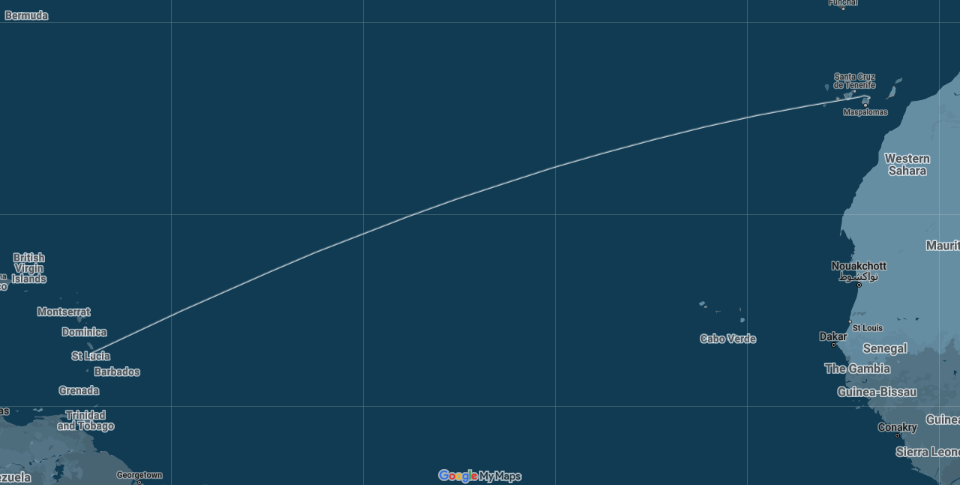
The most popular routes east to west are from Portugal to Barbados which covers 4,100 nautical miles and takes 21 to 31 days to complete, and from Gran Canaria to Saint Lucia which covers 2,700 nautical miles and takes 20 to 25 days to complete.
The best time to complete this route is from 30 November to 28 February.
Weather on an Atlantic Crossing
The weather during a sailing trip across the Atlantic is influenced by a complex interplay of factors. Prevailing wind patterns, such as the Trade Winds and the Westerlies, shape the direction and speed of the vessel’s journey.
Ocean currents, like the Gulf Stream, can accelerate or impede progress, affecting navigation decisions. Atmospheric pressure systems, such as high atmospheric pressure and low-pressure areas, dictate wind strength and weather conditions.
Seasonal variations and geographical features, like the Azores High and the Intertropical Convergence Zone, introduce variability in wind and rain patterns. Additionally, the Atlantic’s vast size and varied geography contribute to regional differences in climate, with the potential for sudden weather changes and the formation of storms.
Weather information and forecasts play a critical role in helping skippers make informed decisions to navigate challenging conditions and avoid potential dangers.
The Right Sailboat to Sail Across the Atlantic
Selecting the appropriate vessel for a transatlantic voyage is a decision that shapes the entire experience.
Monohulls: Monohull sailboats are known for their stability in rough seas and their ability to handle a variety of weather conditions. However, it’s essential to choose a well-built, ocean-worthy vessel designed for long-distance cruising. The right one can provide a level of comfort and convenience that can be especially appealing for those seeking a more leisurely transatlantic crossing.
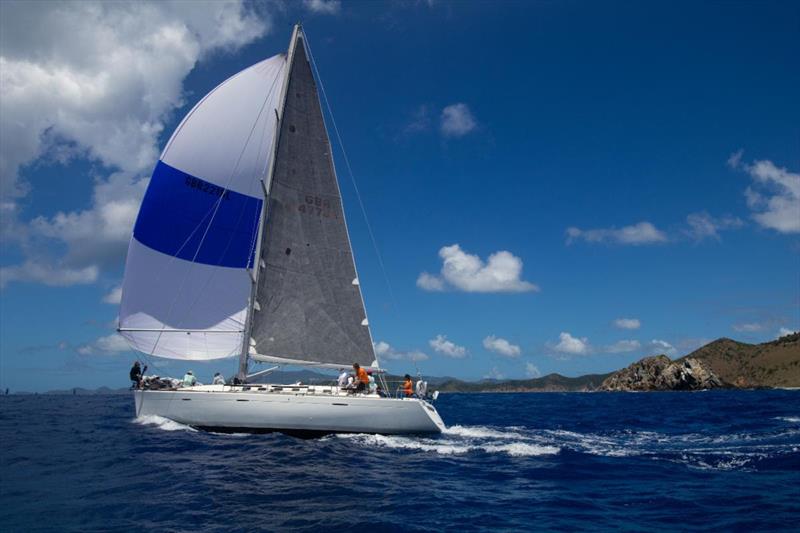
Multihulls: Crossing the Atlantic Ocean on a multihull sailboat, which includes catamarans and trimarans, is becoming increasingly popular due to their unique advantages and capabilities. Multihulls have multiple hulls, which offer benefits in terms of stability, speed, and comfort, as well as much mroe deck space.
Tall Ship: Steeped in history and romance, tall ships evoke the nostalgia of a bygone era. Their majestic masts and billowing sails harken back to the golden age of exploration and offer a unique and authentic seafaring experience. However, despite their size, crossing the ocean with a tall ship has its challenges and demands a skilled crew familiar with traditional sailing techniques.
Unconventional Boats: Many unconventional boats have crossed the Atlantic. British adventurer Roz Savage completed two solo Atlantic Ocean crossings in a rowboat. While others have tried but not yet succeeded in unconventional vessels like Andrew Bedwell who tried to cross in a 3.5 metre vessel.
Technology Onboard
When undertaking an Atlantic crossing, a boat should be equipped with essential technology for safety and navigation. This includes GPS, electronic charts, radar, AIS, communication tools like VHF radio and satellite phone, emergency equipment such as EPIRB and life rafts, navigation and weather software, power generation sources like solar panels and wind generators, and backup systems for redundancy.
Having backup tools, spare parts, and navigational charts ensures preparedness for emergency repairs. Proper familiarity with and maintenance of these technologies are crucial for a successful and secure voyage.
Is Bigger Better?
Ultimately, the “right” boat size for crossing the Atlantic depends on your personal preferences, the type of vessel you’re comfortable with, your sailing experience, and your intended voyage. Smaller boats, including monohulls and multihulls, have successfully crossed the Atlantic Ocean, often with solo sailors or small crews.
It’s essential to match the boat’s size with your skill level, comfort, and the goals you have for your voyage. Proper planning, preparation, and understanding your boat’s capabilities are key to a safe and enjoyable transatlantic crossing.
Who Can Sail Across the Atlantic
The allure of transatlantic sailing transcends skill levels, beckoning both seasoned sailors and those new to the world of seafaring.
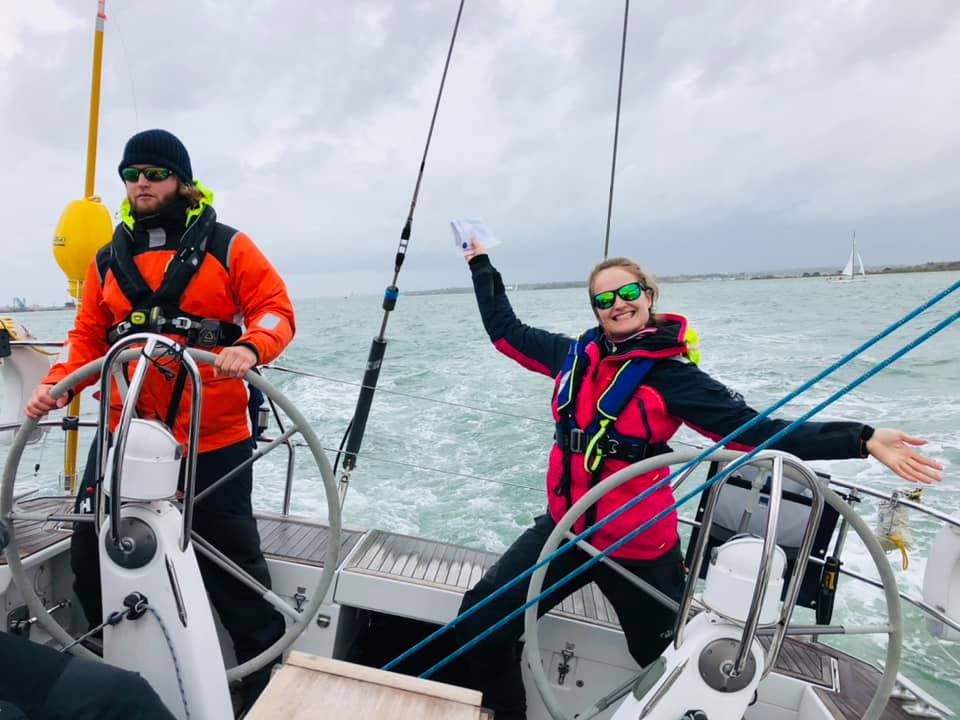
Skill Level
Novices can sail in guided group expeditions. Many sailing schools and organisations offer transatlantic training programs designed to prepare novice sailors for the challenges of open-ocean voyages. These programs cover topics such as navigation, seamanship, weather forecasting, and emergency procedures, ensuring that participants are well-equipped to handle the demands of a transatlantic crossing.
To start gaining more knowledge consider a course like your RYA Day Skipper.
Solo and Groups
Experienced sailors can opt for solo endeavours, navigating the challenges of the open water alone. Solo transatlantic crossings require a high level of skill, self-sufficiency, and mental resilience. Solo sailors must be prepared to handle all aspects of the voyage, from navigation and sail trim to maintenance and emergency repairs. It is not an easy task but a rewarding one.
Group transatlantic voyages offer the opportunity to share the challenges and triumphs of the journey with like-minded individuals. Crew members can provide support, share knowledge, and contribute their unique skills to the overall success of the voyage.
When Is The Best Time To Sail Across The Atlantic?
Navigating the vast expanse of the Atlantic Ocean demands strategic timing to ensure a safe and rewarding transatlantic crossing. Sailors must carefully consider multiple factors when determining the best time to embark on this epic journey.
Avoid Hurricane Season
To mitigate risks, it’s crucial to avoid the peak of the hurricane season, which spans from early June to late November, by planning departures before or after this period.
Trade Winds
The trade wind seasons play a pivotal role. Departing between November and January is ideal for east-to-west crossings (Europe to the Americas), taking advantage of strong easterly winds, while west-to-east voyages (Americas to Europe) are best undertaken from April to June.
Transitional Seasons
The transitional seasons of spring (April to June) and autumn (September to November) offer milder conditions, reducing the likelihood of encountering severe weather. Additionally, the Northern Hemisphere summer (June to August) may provide calmer conditions near specific regions like the Azores and Bermuda due to seasonal temperature gradients.
Monitoring and Flexibility
Even with careful planning, weather conditions can vary. Modern technology, including advanced weather forecasting and satellite communication, allows sailors to monitor changing weather patterns closely. This flexibility enables them to adjust departure dates to align with the most favourable conditions.
What To Expect When You Sail Across The Atlantic
Embarking on a transatlantic voyage is a transformative experience that unveils a variety of emotions and encounters.

Isolation and Self-Discovery
The vastness of the open ocean fosters introspection, offering moments of solitude and self-contemplation. Sailing farther from land, the ocean becomes a place for self-discovery. Away from distractions, sailors connect with their thoughts, gaining profound insights and a deeper understanding of themselves.
Adapting to Dynamic Conditions
Navigating the Atlantic demands adaptability, as calm waters can swiftly turn tempestuous. Sailors encounter a range of weather patterns, from tranquillity to storms. Success hinges on quick decision-making, adjusting sails, altering course, and ensuring safety in rapidly changing wind and wave conditions.
Marine Life and Celestial Wonders
The Atlantic unveils captivating marine life and celestial spectacles. Sailors witness dolphins, whales, and seabirds in their natural habitat. Nights offer starry skies and bioluminescent wonders, like meteor showers, illuminating the transatlantic journey with awe-inspiring beauty.
Camaraderie
The challenges and triumphs of crossing an ocean create a deep bond among crew members. Everyone is on the same journey, facing the same conditions, and working together towards a common goal.
Preparing for Sailing Across The Atlantic
Preparing for a transatlantic crossing demands meticulous planning and a comprehensive understanding of the necessities.
Route and Preparation
Craft a detailed route plan, communication strategies, and contingency plans for a successful transatlantic journey. Thorough preparation is key, covering route selection, departure dates, emergency procedures, and communication protocols.
Consider wind patterns, currents, and potential hazards during route planning. Prepare provisions like food, water, and supplies. Develop contingency plans for adverse weather, medical emergencies, and navigation challenges.
Apparel for All Conditions
Pack layered clothing, foul-weather gear, and safety equipment to adapt to changing weather. Proper clothing ensures comfort and safety. Layering helps regulate temperature, and specialised gear like waterproof jackets, pants, and boots protects against the elements. Safety items like life jackets and harnesses are crucial on deck. Include hats, gloves, and sunglasses for sun protection.
Essential Gear and Tools
Equip with navigation tools, communication devices, safety gear, and spare parts. Success relies on proper gear. Navigation tools (GPS, charts, compasses) aid in plotting courses. Communication devices (satellite phones, radios) keep sailors connected. Safety gear like life rafts, EPIRBs, and flares are vital in emergencies. Carrying spare parts and tools prevents breakdowns.
Stock up on non-perishable food, fresh water, and cooking facilities. Consider food diversity and nutritional balance. Fresh water should be rationed, and watermakers or desalination systems help generate freshwater. Cooking facilities enable meal preparation, accounting for dietary preferences and nutritional needs.
Navigating Legally
Secure necessary permits and documentation for international waters. Crossing boundaries requires permits, visas, and paperwork for foreign ports. Research entry requirements and apply for permits early. Maintain organised vessel documentation for customs and immigration inspections.
Risks of Sailing Across the Atlantic
While Atlantic crossings offer an unparalleled sense of accomplishment, ocean sailing carries some inherent risks.
Weather Challenges
The Atlantic’s unpredictable weather presents dangers from storms to hurricane-force winds. Vigilant weather monitoring and advanced prediction tools help sailors adapt routes and sail plans. A defined storm plan, including course adjustments and reducing sail, is vital for safety in the face of approaching storms.
Health Considerations
Seasickness, fatigue, and medical emergencies require self-sufficiency at sea. Coping with seasickness involves staying hydrated and using medications. Combatting fatigue demands a well-structured watch schedule for adequate rest. Basic first-aid training and well-equipped medical kits are crucial for addressing health issues in remote settings.
Equipment Reliability
Vessel malfunctions demand resourcefulness and preparation. Mechanical, electronic, and communication systems can fail due to the ocean’s rigours. Pre-departure checks and onboard tools aid in identifying and addressing potential issues. Crew members should possess repair skills and improvisational abilities to tackle unexpected breakdowns and ensure vessel safety.
The ARC (Atlantic Rally for Cruisers)
Participating in organized events like the Atlantic Rally for Cruisers (ARC) is one way to cross the ocean. The Atlantic Rally for Cruisers (ARC) is a renowned annual sailing event organised by the World Cruising Club and a favourite in the yachting world. It brings together sailors worldwide and provides an opportunity for sailors to cross the Atlantic Ocean in the company of a group, enhancing safety and camaraderie.
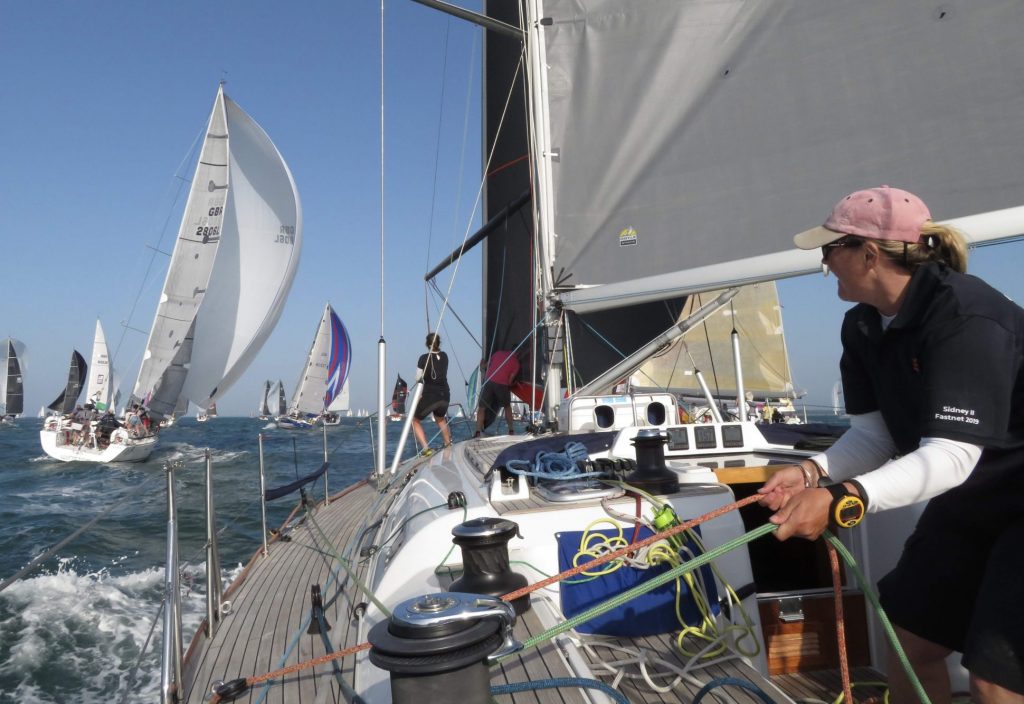
There are three different ARC events, which present three different ways to cross the Atlantic.
The original and most well-known event is the ARC. It typically takes place in November and involves a west-to-east crossing of the Atlantic Ocean from Las Palmas de Gran Canaria in the Canary Islands to Rodney Bay in Saint Lucia, in the Caribbean.
The ARC covers a distance of approximately 2,700 nautical miles and is open to a wide range of sailing vessels, from small cruisers to larger yachts. It offers a combination of bluewater sailing, challenges, and social activities, making it a popular choice for sailors seeking both adventure and community.
ARC Europe is a variation of the ARC that offers a more flexible route for sailors who prefer a northern European departure. It typically starts from a European port (such as Portsmouth, UK) and finishes in the same location as the main ARC event, Rodney Bay in Saint Lucia. ARC Europe provides participants with the opportunity to experience a mix of coastal and offshore sailing as they make their way south to the Caribbean.
The ARC+ is designed for sailors who want to extend their voyage and explore more destinations before reaching the Caribbean. The ARC+ event offers two routes: one starting from Las Palmas de Gran Canaria, as in the main ARC event, and another starting from Mindelo in Cape Verde. Both routes converge in Saint Lucia, giving participants a chance to experience different cultures and sailing challenges along the way.
Each of these ARC events emphasises safety, camaraderie, and adventure. The World Cruising Club provides extensive support, including safety seminars, social events, weather routing, and radio nets to ensure participants have a smooth and enjoyable crossing.
Sailing across the Atlantic Ocean is a remarkable journey that demands a blend of skill, preparation, and a spirit of adventure. While it may seem like a daunting experience, it’s not just for seasoned sailors. With the right boat, people, equipment and preparation it is an accessible, life-changing adventure that almost anyone can enjoy.
Similar Adventures

24th November 2024 to 15th December 2024
Atlantic rally for cruisers 2024 (arc) – a selection of yachts, book your berth on one of a selection of yachts for a transatlantic yacht race between the canary islands and the caribbean., various dates available, cape town to st helena – epic south atlantic adventure, from £6,995 per person, join an atlantic 49 expedition yacht for an unforgettable, 48 day & 4500 nm, sailing trip from cape town to st. helena. one way or return trips available. , 20th march 2024 to 28th march 2024, tall ship: amsterdam to inverness, from £965 per person, the sailing passage will go along the beautiful scottish and english coasts as you enjoy the beautiful scenery and unique wildlife such as dolphins., world arc 2024 & 2025, a round-the-world adventure taking place over 15 months and covering 26,000 nm. following the classic trade winds route, the rally avoids regions of political instability, piracy and storm seasons., how we work.

We take data privacy seriously here at Kraken. You can read more here - Privacy Policy .
Where do I find details of my booking?
Will i be able to book my trip cheaper if i go to the operator directly, can i cancel a booking, what do i need to wear.
Another World Adventures
Sail across the atlantic ocean – join transatlantic sailing voyages, it’s every adventure seeker’s dream to sail across the atlantic ocean..
And we’ve helped hundreds of sailors – new and experienced – to turn that dream into reality.
Find transatlantic voyages here where you book a berth or cabin and join join as hands on guest crew on planned journeys and rallies like the ARC, or if you’d like to charter a whole boat then get in touch .
We work with a network of many incredible boats from luxury yachts, performance racers to historic traditional tall ships.
If you have the ambition to sail across the Atlantic Ocean, whether you’re a beginner or pro sailor, there are exciting options for you on board hands-on sailing vessels. Join yachts or tall ships as guest voyage crew and learn incredible new skills, as you pull together as a team to harness the wind and reach a new continent. It’s a sustainable long-distance travel option that is all about embracing the journey.
Complete our short form to let us know your Atlantic ambitions and we’ll be in touch with exciting options.
Which direction?
A big first consideration for many when planning their transatlantic is which direction to sail – east or westbound and if you’re fixed on that it will determine when you’ll go.
Westbound: Europe to the Americas & Caribbean tend to depart with the trade winds in between October-December.
Eastbound: Caribbean & Americas to Europe tend to sail between March – June (April & May most commonly).
Northbound : South Africa to Europe voyages tend to depart between April-June
How experienced are you?
Our crews are a mix of sailing abilities.
Some enter races and you’d be expected to know what you’re doing, others teach you everything you need to know on the go. You’d just need to join in with a ‘can do’ and ‘here to learn’ attitude and the professional crew will help with the rest!
Want to join a crew for a fixed departure?
We have limited spaces available on organised voyages – these trips are very popular and often book out far in advance.
First step: Explore the listings and make an enquiry on the voyages you’re interested in. You’ll receive more information by email right away and if you asked any questions we’ll get back to those as quickly as possible. In the info you receive is an intro to the skipper or crew office for the boat so you can go ahead and book with them directly if it’s the right fit. These berth options are perfect for solo travellers or couples/pairs/small groups of friends.
Or book a private charter?
Bespoke voyages are organised separately, so reach out to us through the contact form or by email for more details on these.
Or get in touch using the contact form above so we can help you make this trip dream a crossing to remember!
Voyages to sail across the Atlantic 2024 / 2025 and beyond
2024 eastbound.
- Sail from USA to Scotland via Newfoundland 2024 Clipper 60
- Sail from Caribbean (Tortola, BVI) to Azores, to UK on a Celestial Navigation voyage Clipper 60
- Beneteau 40 or Harmony 52 yachts sailing Caribbean to UK
- Sail British Virgin Islands > Azores > UK May/June 2024 – tall ship
- Sail Caribbean to France on a Challenge 67
- Sail Cape to Cape – Chile to South Africa via Antarctica, South Georgia and Tristan de Cuna – tall ship
- Sail New York USA to Lorient France in June 2024
- Lunenburg, Nova Scotia, Canada to Cape Town, South Africa October 2024
2024 Westbound
- May – Sail Lorient, France to NYC, USA
- ARC 2024 Canary Islands to St Lucia on a Beneteau 40 or Harmony 52
- Sail Lorient France to NYC USA in May 2024
- Atlantic Circuit Sail Lisbon to Suriname tall ship
- Luxury 54ft Catamaran sailing Canary Islands to Martinique
- Transatlantic adventure sailing Tenerife to Falkland Islands
- Sail Cape to Cape South America to South Africa via Antarctica tall ship
- Return to Europe sail Caribbean to Rotterdam tall ship
- Sail South Atlantic Falkland Islands to Cape Town via South Georgia & Tristan da Cunha
Check all Atlantic ocean crossings here or email Larissa on [email protected]
Want to sail, but not sure about a transatlantic voyage? We have options for everyone. Check out:
- All sailing adventure holidays
- Ocean adventures
- Tall ship adventures

Tall Ship vs Yacht?
Finding the right boat for your journey is a important part of your planning, not just the route. Each boat has it’s own character, style and charm – and personality! And the on board experience varies hugely depending on the reason for the boat sailing – is it taking part in a race? Is it an ocean cruise slow travel experience? And so on. The degree to which you’ll be mustered to help with the sailing and life on board also varies so whether you’re keen to join a 50ft yacht or a full size tall ship we’re happy to talk you through the options to find the best fit.
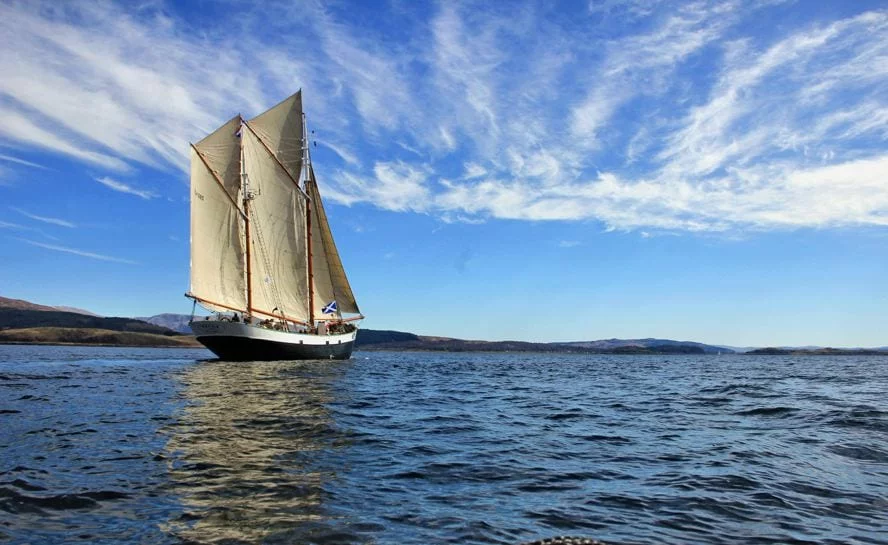
What is it like on Board a Transatlantic Voyage?
Experience navigation, planning and life on board with your fellow crew who will be a mix of ages and from all walks of life.
There’s rarely an upper age limit on the voyages although some of the tall ships have more recently set a limit of 73 for their offshore voyages (please ask for details). Decisions on whether someone is a suitable crew are made on a case-by-case basis by the crew office for each vessel but the key requirement is good health and an enthusiasm to get involved.
Solo Travel Sail Across the Atlantic Ocean
We met as two solo travellers on board a transatlantic voyage, so we understand the opportunities and challenges of solo travel on long journeys at sea.
It was a life-changing experience for us and Another World Adventures wouldn’t exist without that solo travel experience.
The really good news for solo travellers is that when it comes to ocean sailing trips around 80% of the people joining are doing so on their own – so if all of your mates look at you like you’ve grown two heads when you tell them your Grand Plan then don’t worry, you’ll be in great company with the friends you’ll make on board.

Sail with Friends Across the Atlantic Ocean
As well as being an amazing experience for those travelling solo, transatlantic sailing with friends can bond you for a lifetime.
As experienced adventure travel planners, we can connect you with a reliable and responsible vessel that you can join together to make the crossing. Heck, we’ve even known honeymooners celebrate their marriage with an ocean crossing.
All that’s needed is an adventurous mindset to sail across the Atlantic.

Private Charter to Sail Across the Atlantic Ocean
If you are looking for a more personalised experience, we can coordinate bespoke voyages for individuals, groups and companies.
Let us help you find and charter a private vessel for a journey across the Atlantic Ocean.
Whether it’s a bonding experience with friends, a brand contest or marketing effort, or a chance to achieve a life-long dream, we can help you navigate the best vessel choices whether you’re 4 or 40 sailors.
Do I Need Prior Sailing Experience to Sail Across the Atlantic Ocean?
You do not always need much prior sailing experience to take on the challenge of a transatlantic sail although it is advised to ensure you and your fellow crew get the most out of the experience. Afterall, this is a really big experience to go into without knowing if it’s your cup-of-tea. For many of the boats we work with, especially the tall ships, sailing experience is not compulsory. Instead, the vessel crew will give you hands-on experience and training along the way – both on expedition sail yachts and tall ships.
If you’re looking for an experience on a smaller vessel, you might need to have or get some sailing experience or qualifications beforehand. For example, some of the race boats or smaller yachts (60ft) require RYA Day Skipper or equivalent, so speak to us if you’d like more information. A few of the passages are even qualifiers for Yachtmaster Ocean mile makers, so if you have bigger ambitions for your sailing, please reach out to ask about that and about Watch Leader roles, too.
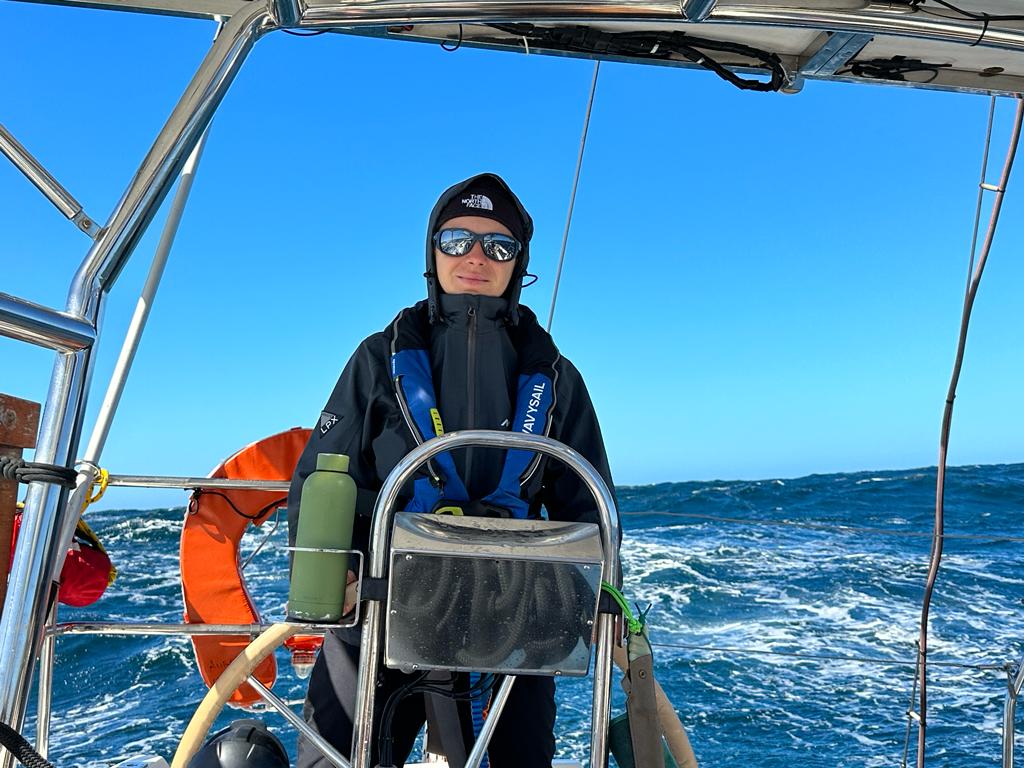
Be Inspired to Sail Across the Atlantic Ocean by our Previous Atlantic Sailing Voyages
Below are some voyages from the past which we’ve left up to give you an idea about routes to consider. If there’s a route you love the sound of but it’s not in the current schedule then just drop us a line to find out more. With so many changes to the sailing schedule for ocean journeys there’s a chance it’s in the planning stages, just not yet announced..!
If you’re not sure of the best option for you, speak to us about your plans and dreams for this great adventure, so we can advise you on the best voyage route and crew to join.

Transatlantic Route inspiration
Past voyages have included
- South Africa to Canada 2019 – January – May 2019 – This was the final leg in a circumnavigation that set off in spring 2018 on board a unique sail training tall ship. Solo travellers were invited to join the crew of this remarkable vessel for the voyage of a lifetime. Unusually for the ocean crossings this voyage included lots of stops along the way.
- Sail Cape to Cape via Antarctica on a traditional tall ship from South America to South Africa.
- Sail Cape Verde to Cuba
- Sail Falkland Islands to South Africa 2018
- Sail Bermuda to the UK on a traditional tall ship
- Sail USA to the UK via the Azores on a Clipper 60 yacht
- Sail Azores to the UK on a tall ship
- Sail Europe to South America on a Dutch tall ship
- Sail USA > EUROPE (Florida to The Netherlands via Bermuda and Azores)
- Sail Antigua and Barbuda to the United Kingdom
- Sail South Africa to Norway via Azores, Ascension Island and St Helena
- ARC – Atlantic Rally for Cruisers Canary Islands to St Lucia (via Cape Verde)
If you see a trip listed here but not on the Atlantic sailing trip page , please contact us to discuss your options. We are constantly updating this list so get in touch if you don’t see a route that works for you and we’ll see what is possible.

Sail Around the World via Cape Horn Square-Rigged Tall Ship
Join the crew of a square-rigged tall ship to sail around the world by way of Cape Horn
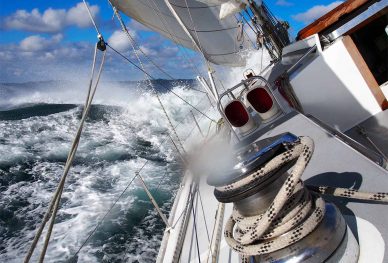
Sail Transatlantic New York City USA to Lorient, France
Embark as a teammate in a transatlantic voyage on a Challenge 67 from USA to France
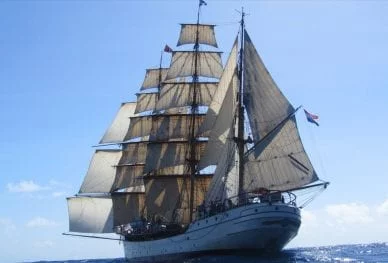
Sail Cape to Cape via Antarctica 2025
A TRUE epic - sail a traditional tall ship from Cape to Cape via Antarctica where you are the crew for 52 days
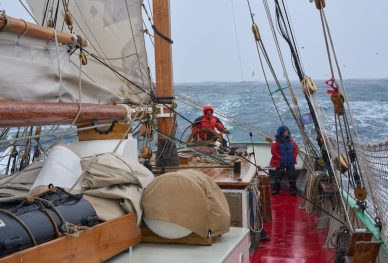

Sail Cape to Cape Chile to South Africa via Antarctica, South Georgia and Tristan da Cuna 2024
Join a Cape to Cape sailing voyage via Antarctica, South Georgia & Tristan da Cuna on a tall ship
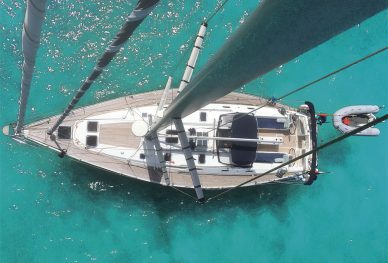
Sail Transatlantic Eastbound to Europe
Sail to Spain from St Martin via Azores on a fantastic 50ft sailing cruiser.
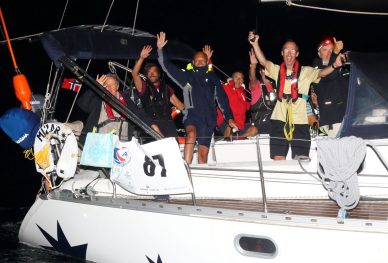
Sail ARC Atlantic Rally 2023
Join the famous Westbound Atlantic Rally crossing on a fantastic sailing cruiser.
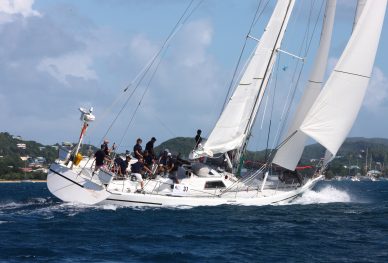
Sail Transatlantic Lorient to New York City
Embark as a teammate in a transatlantic voyage on a Challenge 67 from France to USA
Sail ARC Transatlantic 2024
Embark as a teammate in a transatlantic voyage on a Challenge 67 during the ARC 2024!
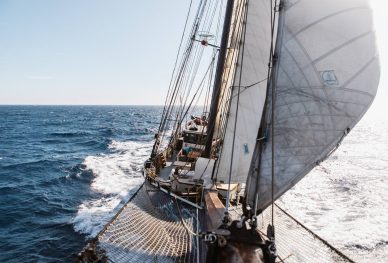
Atlantic Circuit Sailing Adventure
An Atlantic Circuit sailing adventure including two transatlantic crossings and some unusual port stops

Sail Transatlantic Westbound Luxury Catamaran 2024
Embark on the voyage of a lifetime sailing from Gran Canaria to Martinique on an exceptional 54ft catamaran
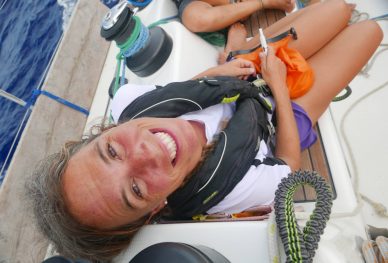
Sail ARC 2024 Transatlantic
The voyage of a lifetime to sail across the Atlantic Ocean with a crew in the ARC 2024.
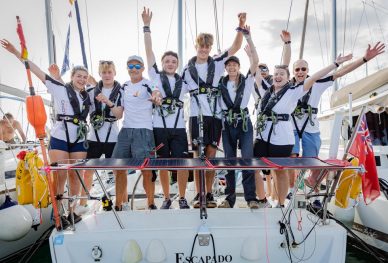
Transatlantic Eastbound Sail Antigua – UK 2024
Join a crew to sail back across the Atlantic Ocean from Antigua to the UK
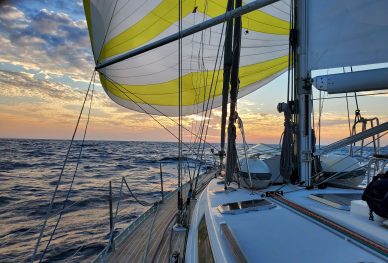
Sail Spain to Canary Islands
Offshore sailing between Malaga and Lanzarote, Canary Islands on a fantastic sailing cruiser.
Sail Around the World As Crew on a Square Rigger
Become crew on an authentic working sailing ship on a global circumnavigation. 20+ ports, 30000 nautical miles
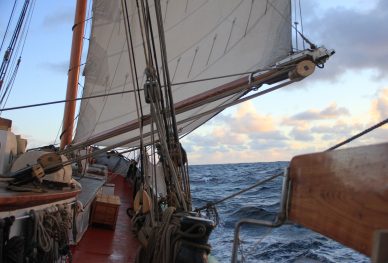
Transatlantic Sailing Tenerife to Falkland Islands
Adventure sailing Tenerife to Falkland Islands from the North Atlantic into the South Atlantic across equator
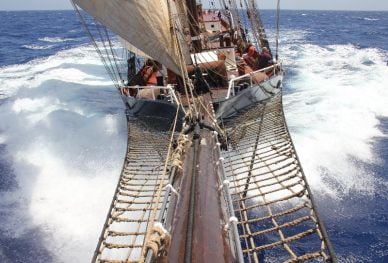
Atlantic Crossing Cape Verde to Fernando de Noronha Brazil DARWIN200 Leg 3
Crossing the Atlantic Ocean from Cape Verde to Brazil Fernando de Noronha.
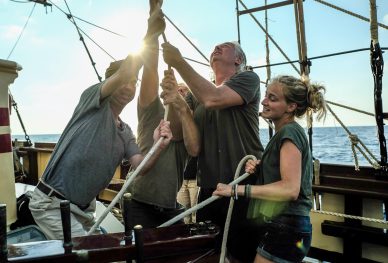
Sail Caribbean to UK via Azores Tall Ship 2024
Hands on sailing a classic brigatine across the North Atlantic from Caribbean to Azores to the UK in May '24
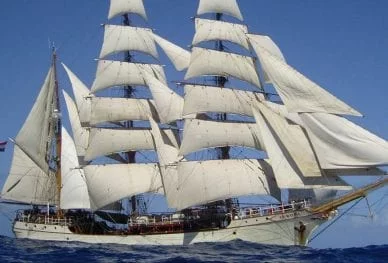
Sail Across the Atlantic Ocean – Cape Town to Montevideo
Experience life at sea as you sail across the Atlantic Ocean on a 100 year old traditional tall ship.
Celestial Navigation Transatlantic Eastbound 2025
Navigate by the stars as you sail across the Atlantic Ocean eastbound from Antigua to UK
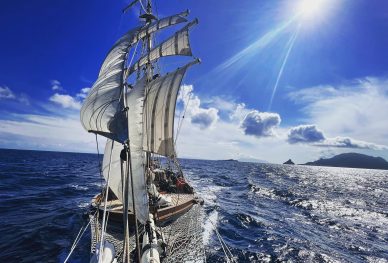
Sail Spain to Barbados on a Traditional Tall Ship 2023
Hands on sailing a classic brigatine across the Atlantic Ocean from Spain to the Caribbean island of Barbados.
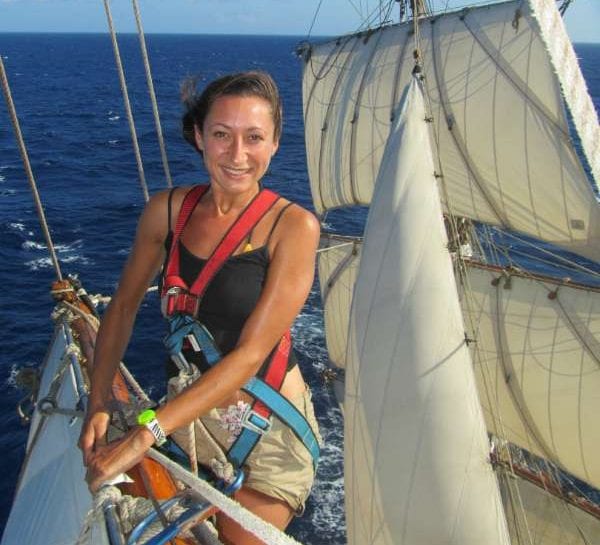
Hi I’m Larissa, Founder of Another World Adventures. Welcome! If you’re planning an adventure you’re in the right place. Get ready to discover epic travel inspo and a collection of hand-picked trips from my trusted network of experienced adventure experts. Think unusual destinations, expeditions, slow, solo and sustainable travel and epic journeys on land and at sea! Ever got a question? Just get in touch, I answer every enquiry myself. Enjoy!
" * " indicates required fields
Follow us on
Responsible Tourism
We believe in ‘creating better places for people to live in, and better places to visit’ through a responsible approach to travel. Read how you can travel responsibly on your adventure.
Our journey began on an ocean adventure sailing across the Atlantic ... find our more and get inspired for your next great trip.
Earn Rewards
We'll donate to a nature project in your name in thanks for using Another World Adventures to find and book a trip.
- Yachting Monthly
- Digital edition

How to sail across the Atlantic with a family
- April 18, 2023
Liveaboard sailing offers amazing adventures and family time, and it’s becoming easier to do, says Sophie Dingwall as she speaks to those who have gone across the Atlantic with a family
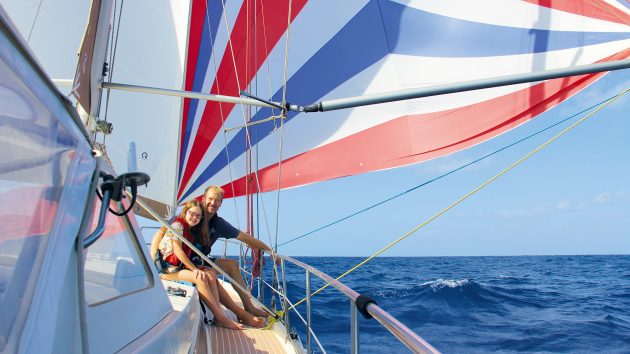
Modern life makes connecting digitally between people easy, but it can also isolate us from friends and family, and the natural world around us. While the negative effects of social media sweep through schools, there is a growing trend, especially among young people, to move away from a shallow online existence and focus on rich real-life experiences instead.
Thanks to the same technology, it is now easier to get away, in search of a more balanced way of life at sea, free from the pressures and expectations of everyday life. While the freedom of life at sea is a lifestyle that has long appealed to non-conformists, leaving the safety of social norms – houses, jobs, schools and the convenience of shops, cars and the internet – is no longer quite as absolute a cutting loose as it used to be.
Thanks to social media and online content, those that have done something similar have been able to share their experiences, offering advice and inspiration to millions of YouTube viewers and Instagram followers. The pandemic also helped to cement the fact that working remotely is not only possible, but increasingly commonplace and achievable, making the idea of being a digital nomad not in the least unusual. The combined effect is that more and more families are prepared to give it a go, whether it’s for a season, a year, or longer-term.
The attraction is clear. Being time-poor and glued to our phones reduces our engagement with both nature, friends and family. While being in a confined space for extended periods with no-one but your own family for company might not be everyone’s dream, for many having time to relax, engage and reconnect with each other is worth making significant sacrifices for.
‘Just do it!’ could be the rallying cry from families crossing the Atlantic, followed by, ‘Life is too short!’ While yachting is lazily assumed to be for wealthy elites only, with a bit of determination it can be surprisingly affordable and accessible to many families.

Stu and Lana Holmes on Amel Super Maramu, Oyai, cross the finish line with their family and crew
Making life changes
By allowing people to work from home and with many able to rent out their home, a location-independent lifestyle is now very much possible. The digital nomad lifestyle is an antidote to the traditional nine to five.
As a result, family entries for the Atlantic Rally for Cruisers have increased and in November 2022, a total of 16 family boats with 24 children crossed the Atlantic with the rally.
Marko Agthe, an environmental engineer from the landlocked town of Mücheln in the centre of Germany, purchased a Jeanneau Sun Legende 41 with his wife, Claudia and two daughters, Luise, 13 and Juliane, 16. He said, ‘We’re not considered normal from where we come from.’ It took three years to prepare their 1986-vintage boat, Good Fellow, for ocean sailing, replacing many of the sails, adding new standing rigging, electronics, water systems and a watermaker to bring her up to spec.
Marko’s daughter, 16-year-old Juliane, says, ‘We sailed a lot in the Baltic Sea, but I found it boring after a while. So, when we started to explore further afield, I was excited because I got to see new things and dolphins for the first time – it was incredible. The longest passage I’ve done so far has been four days, but I’ve seen St Lucia in a seminar, and I can’t wait to go there!’
Similarly, German couple Isa and Florian Tanger, owners of Sima, a Bavaria 42, live on board with their two little girls, Merle and Laura. Laura won the prize for the youngest entry at only two years old and won the hearts of everyone with her salt blonde, bouncy curls, rosy complexion, and intrigue for adventure and was often found fishing for sea creatures only to catch seaweed in a ploy to feed it to the adults.

Agthe family members enjoyed their meals together
Germany has one of the most generous family leave policies in the world. Parents are entitled to up to three years of leave, with the option to return to their job afterwards – something Isa and Florian have used to their advantage. ‘We have normal jobs, I am a logistics manager in a boatyard and Isa is a marine biologist. We saved for the trip with our family and have rented out our small house in Kiel. It was and still is scary sometimes but, just do it!’ says Florian.
Since living on board, the couple has a more balanced family life, allowing them to take an equally active role in raising their children.
Leaving school
But what about those children already rooted in the school system? Mainstream schools are regimented, adhering to fixed timetables and strict curriculums – quite the opposite of home schooling on a boat with no fixed abode, governed almost entirely by the weather. So, what are the advantages and disadvantages of removing a child from mainstream education?
The parents’ consensus is that the unique experience generates new perspectives and life lessons that are incomparable or even impossible with traditional education models. But, most importantly, it allows the family to spend honest, valuable time together. However, there are legalities, which differ depending on where you live, so be prepared to jump through some hoops and take on the role as a teacher.

The Agthe family on their Jeanneau
Going sailing for an extended period can give children a hands-on knowledge of how the world works. For example, using finite resources on board can help them appreciate where the commodities come from that we all consume, such as food, water and power or fuel, giving them a much greater holistic awareness of their place within the world. These situations invoke a higher level of maturity too. Alex, 13, from Take Off says, ‘I’m most looking forward to finding ways to entertain myself without connection, without my phone and simply being social with my family.’ With so many digital distractions, Alex understands that being in the moment isn’t enough for him – it has to be learned.
Educational resources differ from the classroom. For example, marine life, historical architecture, foreign food and new cultures present an entirely different range of topics to explore, as well as providing vast opportunities for child-led learning, to take in literacy, numeracy and critical thinking, alongside art, the sciences, history and a whole lot more.
Children also gain a wider awareness of the physical effort of travelling from one place to another and an increased respect for nature and the elements. Juliane, for example, is developing her interest in the ocean, contributing to the ocean’s health by collecting microplastics and recording the data. Meanwhile, Alex plans to complete his dive qualifications in the Caribbean, embracing the unique opportunities when enrolling in the school of life at sea.

The Tanger family two-year-old Laura with her seaweed catch
Home from home
Daughters Aria, 13, and Micah, eight, are sailing with parents Stu and Lana, on their 2002 Amel Super Maramu Oyai for a total of 16 months. Despite the limited space, the girls’ cabin situated forward is equal to that of a home on land, cheerfully decorated with cuddly toys nestled into cubby holes and walls almost entirely covered with drawings, posters and trinkets.
‘Let me show you where all the treats are stowed!’ says Aria excitedly as she unhinges a floorboard in the saloon, still clutching one of her many soft toys to reveal a treasure chest of their favourite biscuits and other sugary supplies.
Involving the children in the planning and preparation is paramount, from ensuring they know where relevant safety equipment lives to where the goodies are kept.

Stu Holmes, with his daughters Micah and Aria practise navigation, log keeping and the numeracy and literacy skills that go with it
And worrying about entertaining them might not be as hard as you think. The antidote to boredom is to create group activities, says Lana: ‘It’s Stu’s job to keep everyone safe and my job to keep everyone happy. I have a supply of books, games and crafts to entertain us.’
Those with siblings will often keep themselves entertained on board. Alex says, ‘When I crossed the Atlantic when I was younger, I remember playing hide and seek with my sister for hours together, we were never bored.’

Micah and Aria Holmes found ways to make their boat homely, with plenty of treats
Finding community
The children hold a significant place in the ARC’s community, all feel the strong bond and care for each other. At the start of the ARC Rally, a ‘kids’ club’ runs daily, giving the children an appreciation of the local wildlife and marine environment, broadening their horizons, and allowing them to become more involved in the local community.
The children develop physical and mental resilience by teaching practical skills such as dinghy sailing, kayaking and horse riding, helping them build strong friendships with peers and adults. The kids’ club has helped the children make new friends, find their own identities, gain confidence and a better understanding and knowledge of the world outside of school. ‘Most of the other kids are on the same dock, and I think the kids’ club is really great because I’ve made lots of friends,’ says Ellinor from Sweden.

Friends reunite after the ARC Rally arrival
Ellinor’s mother, Sofia adds, ‘The kids’ club is good for her and us. We have time to get jobs done while she enjoys herself with her new friends. She studies English but being here we’ve noticed it’s improved significantly. ‘As a parent, it’s hard to know if you are doing the right thing but we think the time we spend together as a family is positive.
‘Ellinor has already experienced so much, and the biggest adventure is still to come! It’s important Ellinor goes to school to have a balance and can reach the next level in her education too.’
Communications
Typically, the cruisers yield themselves to nature and the freedom that comes with it, often engaging with modern communications but less than the average user. ‘We spend more family time together and learn how to live and enjoy the moment, away from distractions,’ says Marko.

Aria Holmes takes on radio duties for the fleet radio net
While it is something to escape for many, social media has helped to open people’s eyes to the possibilities out there and made the adventure of stepping into the unknown seem more attainable, including cruising communities like the ARC Rally.
Marko, owner of Good Fellow has a contract with a German TV crew and is documenting their journey from the everyday chores down to the nitty-gritty. He says, ‘For me, it’s important to highlight this lifestyle and show the German people how much the children can learn from an experience like this. The government view this as a “holiday” but it is so much more. We’re surrounded by once-in-a-lifetime experiences and opportunities that my children are learning so much from.’

The ARC 2022 children all quickly made good friends, and kept in touch on the crossing
Schooling alternatives
The first thing to do is familiarise yourself with the rules and regulations in your country and then contact the educational authorities for the relevant policies available.
In the UK, for example, you as a parent (rather than the state) are legally responsible for ensuring your child receives an education, and the government or council have very little jurisdiction over you in this. Your local council will want to know that if your child is not in school that they are being properly looked after and educated, but you are not accountable to them for the education they receive.
It is worth noting that the UN’s Convention on the Rights of the Child requires states to prove a right for children to express their views and for due weight to be given to those views, in accordance with the age and maturity of the child.

Juliane enjoyed working on her artwork skills in a ‘classroom’ which her friends would envy!
Home schooling is more likely to work if you have discussed ideas as a family, and the children have been able to contribute to the plans you make.
What boat school looks like, however, is wide open. There’s often more than one route to go down, and options vary from structured curriculums to flexible systems whereby parents can tailor curriculums to their timescale, location and agenda – often better suited to the cruising lifestyle. Parents often report that home schooling is the hardest part of their lifestyle and that maintaining contact with teachers is crucial for the children’s education and their parents’ sanity. Luckily, technology today makes this easily achievable and relatively cost-effective too.
You may want to be fairly unstructured and use child-led learning, letting your child pursue interests as they naturally occur from your travels, though this isn’t without its challenges. For those taking a finite amount of time out of mainstream education before a planned return to school, however, keeping up with what peers at home are learning is important.
Many parents choose to use tutors, remote learning or even following their home school curriculum while they are away. Seek out the experts and other support to ensure your children are educated to similar standards to mainstream schools.
Enjoyed reading this?
A subscription to Yachting Monthly magazine costs around 40% less than the cover price .
Print and digital editions are available through Magazines Direct – where you can also find the latest deals .
YM is packed with information to help you get the most from your time on the water.
- Take your seamanship to the next level with tips, advice and skills from our experts
- Impartial in-depth reviews of the latest yachts and equipment
- Cruising guides to help you reach those dream destinations
Follow us on Facebook , Twitter and Instagram.
- How it works
- Frequently asked questions
Atlantic crossing by boat

- ⭐ Is it necessary to plan the route to Cross the Atlantic? Sailing across the Atlantic is a high-seas sailing activity and, therefore, it is essential to plan the route to minimize setbacks and navigate with favorable winds and currents.
- ✅ What is the best time to cross the Atlantic? The best time to cross the Atlantic by sailboat from Europe or Africa to the American continent is between the months of October and January, coinciding with the arrival of the Trade Winds and the low season of hurricanes in the Atlantic Ocean.
- ⌚ How long does it take to cross the Atlantic by sailboat? The transatlantic crossing can last between 15 and 30 days, depending on the capabilities of the ship and the route they intend to take.
- ⚡ Is it dangerous to cross the Atlantic by sailboat? The main danger involved in crossing the Atlantic by sailboat are tropical storms and hurricanes. For this reason, the crossing is always carried out once the hurricane season ends, to avoid the risk of encountering these meteorological phenomena.
- ✍ Do I need experience to cross the Atlantic by boat? It is not necessary that you have specific nautical skills to embark on an Atlantic crossing, although it is advisable to have some experience in navigation.
- ➡️ How much does it cost to cross the Atlantic by sailboat? As you can see in Sailwiz, the price of the Atlantic Crossing varies depending on the type of ship and what is included in the package, although in general, the tickets usually start at 1,000 euros.
- If you have always dreamed of crossing the Atlantic but have never dared, this is the time to make it happen. You just need to enjoy the adventure and some time (around a month) to cross the Atlantic by sailboat.
Crossing the Atlantic by boat: start of the season
On what dates do the crossings depart to cross the atlantic by sail from europe, from which ports do you leave to cross the atlantic, what itinerary do the atlantic crossings that leave europe follow, what are the main dangers in the crossing of the atlantic, how is tall navigation across the atlantic, what dates do the atlantic crossings depart from the caribbean to europe, what itinerary do the atlantic crossings that leave the caribbean follow, how much fuel is needed to cross the atlantic.
- We call you
- Write us by WhatsApp Talk to us at +39 065 326 613 4
- Contact Form We write your needs or doubts
- Shall we call you? Leave us your number and we will call you

How Long Does It Take to Sail Across the Atlantic? Expert Insights and Tips
Alex Morgan
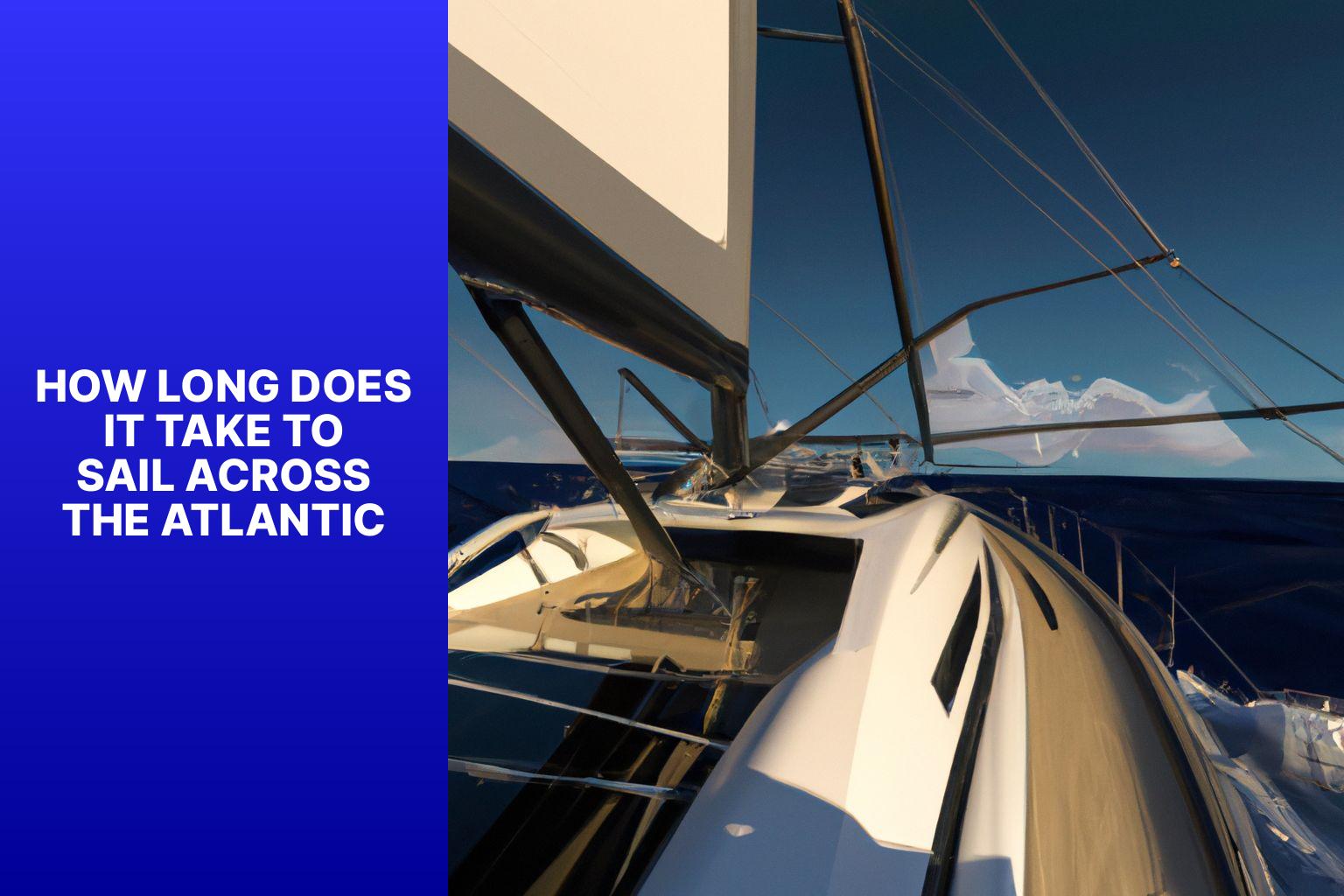
Sailing across the Atlantic is a thrilling adventure that captures the imagination of many sailors and adventurers. It is a journey that requires careful planning, preparation, and an understanding of the factors that can influence the duration of the trip. In this article, we will explore the different aspects of sailing across the Atlantic and provide insights into the typical timeframes for completing this epic voyage.
The transatlantic route is a well-known passage that connects the continents of North America and Europe. Most commonly, sailors embark on their journey from the East Coast of the United States and head towards Europe, with the Azores serving as a common waypoint along the way. Alternative routes exist that can take sailors to different parts of Europe or even Africa.
The duration of the journey is influenced by several factors. The type of vessel used plays a significant role, as a faster and more efficient boat can cover the distance in a shorter amount of time. Weather conditions, including wind patterns and the presence of storms, can either speed up or delay the progress of the journey. The chosen sailing route, which can vary based on navigational strategies and personal preferences, also affects the duration. The speed at which the vessel sails, as determined by its design and crew’s skill, impacts the overall timeframe.
Typically, sailing across the Atlantic can take anywhere from a few weeks to several months. The fastest recorded time for crossing the Atlantic stands at just over 5 days, accomplished by high-performance sailing yachts. The average duration for most sailors falls between 2 to 4 weeks. It is important to note that these timeframes can be impacted by factors such as weather delays, unforeseen challenges, and the specific characteristics of the vessel being used.
To ensure a successful transatlantic crossing, proper planning and preparation are essential. This includes selecting a suitable vessel, stocking up on necessary supplies and provisions, and ensuring the crew is well-trained and equipped for the journey. Safety measures such as having life-saving equipment, practicing good seamanship, and following navigational best practices are also crucial. maintaining communication and navigation systems, including satellite communication and GPS, are vital for safety and staying on course.
Capturing the experience of sailing across the Atlantic through photography, journaling, or other means can help create lasting memories and share the journey with others.
1. Sailing across the Atlantic offers unique challenges and rewards, making it a thrilling adventure for sailors. 2. The most common route for sailing across the Atlantic is from Europe to the Americas, but there are alternative routes available. 3. The duration of the journey is influenced by factors such as the type of vessel, weather conditions, sailing route, and sailing speed. 4. The fastest recorded time for sailing across the Atlantic is impressive, but the average duration can vary depending on various factors. 5. Successful transatlantic crossings require proper planning, preparation, safety measures, navigation, and communication. 6. Capturing the experience of sailing across the Atlantic can create lasting memories and enrich the journey. 7. Sailing across the Atlantic is an adventure filled with challenges, discoveries, and a sense of accomplishment.
The Transatlantic Route
The Transatlantic Route connects Europe with the Americas and can take 10 to 30 days to sail, depending on weather conditions.
Sailors must consider weather, wind patterns, and currents to successfully navigate The Transatlantic Route .
The most common route starts in Europe, heads towards the Canary Islands , and crosses towards the Caribbean or the United States .
During the crossing, sailors must be prepared for changing weather conditions, including storms and high seas, along The Transatlantic Route .
They need sufficient provisions, fuel, safety equipment, communication, and navigation systems for the journey.
Experienced sailors may participate in races such as the Atlantic Rally for Cruisers (ARC) which happens yearly and attracts sailors from around the world.
The race provides an opportunity for sailors to challenge themselves and enjoy the thrill of crossing The Transatlantic Route together.
Sailing The Transatlantic Route requires careful planning, skillful navigation, and a sturdy vessel capable of withstanding the challenges of the open ocean.
It is an adventure that tests both the physical and mental endurance of sailors and offers a unique experience crossing one of the world’s largest bodies of water.
What is the Most Common Route for Sailing Across the Atlantic?
The most common route for sailing across the Atlantic is the Trade Winds route. Sailors typically start from the eastern coast of North America or the Caribbean and navigate towards Europe in a diagonal path. This route takes advantage of the prevailing winds and eastward currents in the Atlantic Ocean .
The Trade Winds route provides favorable sailing conditions due to the steady eastward winds. Sailors can maintain a consistent speed throughout their journey, and the North Atlantic Drift current also assists in their progress.
During the voyage, sailors often make stops at islands such as the Azores or the Canary Islands to restock supplies and take a break. These islands also serve as waypoints for adjusting their course.
Although the Trade Winds route is the most common, sailors have the option to choose alternative routes based on their preferences and the prevailing conditions they encounter.
Careful planning of the route is essential for sailors, considering factors such as weather conditions, potential hazards, and desired destinations. Navigation tools like GPS and nautical charts are necessary for a safe and successful crossing.
What are the Alternative Routes for Sailing Across the Atlantic?
Alternative routes for sailing across the Atlantic offer different experiences and challenges.
1. The Northern Route: Sail from Europe to North America, passing through the North Atlantic. It is popular for its picturesque landscapes and encounters with icebergs, attracting adventure seekers.
2. The Southern Route: Sail from Europe to South America, passing through the South Atlantic. Explore beautiful islands like the Azores and Cape Verde, and enjoy favorable trade winds.
3. The Equatorial Route: Sail near the equator, crossing the Atlantic from Africa to South America or vice versa. Experience crossing the equator and navigating the unpredictable doldrums, where winds are calm.
4. The Transpacific Route: Sail from the Americas to Asia, crossing the Pacific Ocean. While not strictly an Atlantic route, some sailors choose this option for a round-the-world journey. The Pacific crossing is known for long distances, challenging weather patterns, and opportunities to visit stunning islands.
When considering alternative routes, sailors should take into account weather conditions, prevailing winds, currents, and seasonal variations. Careful planning is crucial, considering the vessel’s capabilities and the crew’s experience.
The choice of alternative routes for sailing across the Atlantic depends on sailors’ preferences and goals. Each route offers unique experiences and challenges, so choose one that suits your sailing style and aspirations. Happy sailing!
Factors Influencing the Duration of the Journey
When it comes to sailing across the Atlantic, the duration of the journey is influenced by several key factors. From the type of vessel to the weather conditions, sailing route, and speed, each aspect plays a crucial role in determining how long the voyage will take. So, whether you are a seasoned sailor or simply curious about the challenges one might face on this epic journey, let’s dive into the exciting variables that affect the duration of the Atlantic crossing.
Type of Vessel
The type of vessel used for sailing across the Atlantic greatly impacts the journey duration. Factors like size, design, and performance determine the speed and efficiency of the vessel.
Each type of vessel has advantages and disadvantages for transatlantic sailing. Cruise ships and yachts provide comfort but may lack speed. Sailboats and racing boats rely on wind power, but may sacrifice comfort and amenities due to their smaller size. Cargo ships are durable and can withstand weather conditions, but are not designed for passenger comfort.
Historically, various types of vessels have been used for transatlantic crossings. The first successful crossing was made by the steamship SS Savannah in 1819. Technological advancements have since led to more efficient and specialized vessels for transatlantic voyages.
Weather Conditions
Weather conditions are crucial for determining the success and duration of a transatlantic sailing journey. Wind direction and strength greatly impact the speed and efficiency of the sailing vessel, while the state of the sea, including wave height and swell , affects the comfort and safety of the sailors.
Stormy conditions, like strong storms such as hurricanes, pose significant risks that sailors must carefully monitor. Additionally, dense fog impairs visibility, making navigation difficult. It is vital to stay updated on weather conditions by monitoring reliable weather forecasts, utilizing advanced navigational tools like radar and GPS, and having contingency plans in place.
Incorporating these measures can enhance the safety and the overall voyage experience in the Atlantic Ocean.
Sailing Route
When planning a transatlantic sailing journey, it is important to carefully choose the right sailing route. There are several options to consider. One common route is the Trade Wind Route , which takes advantage of the prevailing Trade Winds that blow from east to west. This route is typically used for sailing from Europe to the Caribbean or the east coast of the Americas .
Another popular route is the North Atlantic Great Circle Route , which follows the shortest distance between two points on a globe. This route takes sailors from Europe to the east coast of the United States or Canada . It can be more challenging due to unpredictable weather conditions.
For those looking for a more adventurous route, the Southern Atlantic Route is a great option. This route involves sailing south from Europe , around the Cape of Good Hope in South Africa , and then heading west across the Southern Atlantic to reach South America or the Caribbean .
When choosing a sailing route, it is important to consider factors such as weather patterns, prevailing currents, and the capabilities of your vessel. Consulting nautical charts, weather forecasts, and experienced sailors can provide valuable insights to help you make an informed decision.
Here are some suggestions for planning your transatlantic sailing adventure:
– Research and familiarize yourself with the chosen route to understand the unique challenges and requirements it may present.
– Ensure your vessel is well-maintained and equipped with the necessary safety gear, navigation instruments, and communication devices.
– Stay updated with weather forecasts and plan your departure accordingly to avoid adverse weather conditions.
– Consider joining sailing forums or communities to connect with experienced sailors who have sailed similar routes and learn from their insights.
Sailing Speed
Sailing speed is a crucial factor to consider when embarking on a transatlantic journey. The ability to sail at a faster speed allows for quicker progress and ultimately leads to a shorter travel time. Various factors influence the speed at which a vessel can sail, including wind conditions and the design of the boat. Having strong and consistent winds can significantly increase the sailing speed , resulting in a reduction in crossing time. Conversely, when faced with unfavorable weather conditions such as calm or headwinds, the sailing speed can be slowed down, thereby prolonging the journey.
It is important to note that the type of vessel also plays a role in determining its speed. High-performance racing yachts tend to sail faster than cruising boats, which may have a slower speed. To optimize sailing speed, it is essential to carefully configure the sails and take advantage of favorable currents. Experienced sailors strategically adjust their course to make the most of wind patterns and currents, allowing them to achieve a faster sailing speed. On average, the sailing speeds for transatlantic crossings typically range from 5 to 10 knots , depending on the prevailing conditions.
It is worth mentioning that a faster speed ultimately shortens the journey time, while a slower speed can prolong the crossing. Therefore, it is crucial to regularly monitor and make necessary adjustments to the sailing speed to ensure efficient progress towards the intended destination.
Typical Timeframes for Sailing Across the Atlantic
Embarking on a journey across the vast Atlantic Ocean is an awe-inspiring endeavor. So, how long does it really take to sail across this magnificent body of water? In this section, we’ll uncover typical timeframes for sailing across the Atlantic . From the fastest recorded time to the average duration, we’ll explore the factors that can impact the duration of this incredible voyage. Brace yourself for a fascinating exploration of the time it takes to traverse this iconic oceanic expanse. Let’s set sail!
Fastest Recorded Time
The trimaran IDEC SPORT, skippered by French sailor Francis Joyon , achieved the fastest recorded time for sailing across the Atlantic in 2017. Joyon completed the journey in 40 days, 23 hours, 30 minutes, and 30 seconds , breaking the previous record set by Thomas Coville in 2016.
This accomplishment showcases the advancement of sailing technology and the capabilities of highly skilled sailors. It also serves as a historical milestone, inspiring others to push their limits and attempt to further reduce the duration of the transatlantic crossing.
Average Duration
The duration of sailing across the Atlantic varies depending on factors such as vessel type. Here is a table showing typical timeframes for different types of vessels:
These durations can be influenced by factors such as weather, route, and speed. Crew skill, stops, and detours can also impact the timeframe.
When planning a transatlantic crossing, consider the average duration based on your vessel type. This helps with preparation, ensuring you have enough supplies and resources.
Remember, sailing across the Atlantic requires planning, safety measures, navigation skills, and communication abilities. Capturing the experience through photos, videos, or journals can enhance the journey.
Factors That Can Impact the Duration
The duration of a transatlantic sailing journey can be impacted by the type of vessel, weather conditions, sailing route, and sailing speed. Let’s explore these factors in a table:
To ensure a successful transatlantic crossing, it is important to consider these factors and plan accordingly. Choose a vessel that suits the intended purpose and desired speed. Stay updated with weather forecasts and plan the route to take advantage of favorable conditions. Maintain a steady and efficient sailing speed to optimize the journey time. Monitoring the factors that can impact the duration will help ensure a safe and enjoyable transatlantic crossing.
Tips for a Successful Transatlantic Crossing
Embarking on a transatlantic crossing? Look no further for essential tips to make your journey a success! From proper planning and preparation to staying safe with swift navigation and communication, we’ve got you covered. Capturing the unforgettable experience that awaits you will be a breeze. So get ready to set sail and conquer the mighty Atlantic with confidence and finesse!
Proper Planning and Preparation
Proper planning and preparation are essential for a successful transatlantic crossing. To ensure a smooth journey, it is important to follow these steps:
1. Conduct thorough research on the transatlantic route and familiarize yourself with both the common and alternative routes available.
2. Stay updated with the weather conditions for your intended time of the journey. Continuously monitor the forecast and weather patterns to select the optimal starting time and to plan for any potential storm systems.
3. Carefully select an appropriate vessel for the journey, taking into consideration factors such as size, stability, and its ability to withstand long voyages.
4. Develop a detailed itinerary that includes planned stops, estimated durations at each stop, and the necessary fuel and food requirements.
5. Remember to pack essential supplies , including food, water, navigation equipment, safety gear, and spare parts that may be needed for potential repairs.
6. Regularly maintain the vessel by thoroughly checking all systems, including the engine, sails, rigging, and electronics.
7. Ensure you have obtained all necessary documentation and permits , such as passports, visas, and clearance from customs and immigration authorities in the countries you plan to visit.
8. Inform your family and friends about your planned route and provide them with an estimated time of arrival at each destination.
9. Stay informed about current regulations and safety guidelines for sailing across the Atlantic.
By diligently following these steps, you can be well-prepared for your transatlantic crossing, greatly enhancing the likelihood of a safe and successful journey.
Safety Measures
When sailing across the Atlantic, it is crucial to prioritize safety by following a variety of safety measures. Here are some key guidelines to consider:
– First and foremost , regularly maintain the vessel to address any potential structural and mechanical issues that may arise.
– It is essential to equip the boat with necessary safety gear such as life jackets, flares, a first aid kit, and a life raft .
– Ensure that there is a reliable communication system installed on board to stay connected with the shore and other vessels in case of emergencies.
– Keep a close eye on weather conditions and be prepared to make necessary adjustments to the sailing route or even delay the journey if the weather becomes unfavorable.
– Have a clear and well-defined emergency plan in place for situations such as man overboard incidents, fire outbreaks, or equipment failures.
– It is vital for all crew members to undergo comprehensive safety training, encompassing navigation skills, emergency procedures, and first aid knowledge .
– Implement regular watch schedules , especially during nighttime passages, to ensure consistent surveillance.
– Minimize risks by adhering to international maritime regulations , utilizing navigational aids, and maintaining a safe distance from other vessels.
– Always have updated charts and navigation tools readily available onboard, and make it a habit to regularly update them as needed.
By conscientiously adhering to these safety measures, you can significantly enhance the safety and enjoyment of your transatlantic sailing experience.
Navigation and Communication
During a transatlantic sailing journey, navigation and communication are crucial. Here are some important considerations for sailors:
1. Marine charts and electronic navigation systems: Sailors need up-to-date marine charts with detailed route and hazard information. GPS can enhance accuracy and provide real-time positioning for navigation.
2. Communication devices: Reliable means of communication are essential. VHF radios allow sailors to communicate with other vessels and coast guard stations for safety and emergencies. Satellite phones and EPIRBs provide additional communication channels in case of emergencies.
3. Weather forecasting: Monitoring weather conditions is crucial for safe navigation. Sailors can use onboard and satellite weather forecasting services for accurate updates, helping them make informed decisions and avoid severe weather.
4. Navigation techniques: Familiarity with celestial navigation methods, like using a sextant , can be useful in case of equipment failure. Sailors can also rely on radar, depth sounders, and electronic charts for safe navigation.
5. Collision avoidance: Vigilance is key. Sailors should use radar and AIS to detect other vessels and avoid collisions. Proper communication and adherence to COLREGs (International Regulations for Preventing Collisions at Sea) are important for safe navigation.
During my transatlantic sailing trip, I had an unforgettable experience that highlighted the importance of navigation and communication. While navigating through dense fog, our radar detected a large cargo ship heading towards us. We immediately contacted the ship using the VHF radio, alerting them to our presence and the potential collision risk. Through effective communication and quick maneuvering, we were able to avoid a dangerous situation. This experience reinforced the need for staying alert and having reliable communication systems while sailing across the Atlantic.
Capturing the Experience
To capture the experience of sailing across the Atlantic, consider the following:
1. Bring a high-quality camera or smartphone to document the journey. Capture sunsets , ocean views , and wildlife encounters .
2. Record videos of the boat’s motion, the sound of the waves, and the feeling of being on the open sea .
3. Keep a journal to write down thoughts, feelings, and memorable moments. Describe challenges , triumphs , and personal growth during the journey.
4. Create a scrapbook with photographs , postcards , and mementos collected along the way. Include maps and notes to chronicle the route.
5. Conduct interviews with fellow crew members to gather different perspectives and stories. This adds depth to your documentation and creates a comprehensive narrative.
6. Share your experience on social media or through a blog . Connect with others who share your passion for sailing or are interested in your journey.
7. Organize a slideshow or presentation to showcase your adventure to friends and family. Relive the experience and inspire others to embark on their own sailing adventures.
Fact: A study published in the Journal of Travel Research shows that capturing experiences through photography and journaling enhances memory and increases overall satisfaction with the travel experience.
Some Facts About How Long Does It Take To Sail Across The Atlantic:
- ✅ The average time it takes to sail across the Atlantic is 20 to 25 days, but it can be completed in as little as two weeks if you are lucky, take shortcuts, and have a fast sailboat. (Source: Our Team)
- ✅ The journey can take about three to four weeks, covering a distance of about 6,800 km. (Source: Life of Sailing)
- ✅ The most common route from East to West follows Portugal – The Canary Islands – Cape Verde – Windward Islands, covering a distance of about 6,800 km. (Source: Improvesailing)
- ✅ Timing is important to avoid the hurricane season, which lasts from June to November. (Source: Improvesailing)
- ✅ Improved sailing technologies, hull shapes, boat efficiency, and navigation techniques have made crossing the Atlantic faster. (Source: Improvesailing)
Frequently Asked Questions
1. how long does it typically take to sail across the atlantic.
On average, it takes about 20 to 25 days to sail across the Atlantic. The duration can vary depending on factors such as the type and size of the sailboat, weather conditions, and the route chosen.
2. What is the best time of year to sail across the Atlantic?
The best time to sail across the Atlantic is between November and February. During these months, the water is warmer and the chances of encountering hurricanes are lower, making the journey safer and more comfortable.
3. What are the main routes for crossing the Atlantic?
There are two main routes for crossing the Atlantic: east to west and west to east. The northern passage involves sailing from America to Europe, with departure ports typically in New York or Bermuda. The southern passage entails sailing from Europe to America, with departure ports usually in Southern Spain or the Canary Islands.
4. What factors can affect the duration of an Atlantic crossing?
Several factors can influence the duration of an Atlantic crossing, including the type and speed capabilities of the sailboat, the location of departure, and the weather conditions encountered during the journey. The skill and experience of the sailor can also play a role.
5. What are some essential preparations for sailing across the Atlantic?
To be well-prepared for an Atlantic crossing, it is important to create a time scale, choose the most suitable route, have a budget, and select a qualified and experienced crew. Having a sturdy boat with durable sails, proper navigation gear, and sufficient fuel is crucial for a successful journey.
6. Are there any shortcuts or strategies to complete the Atlantic crossing faster?
While the average duration of an Atlantic crossing is 20 to 25 days, it is possible to complete the journey in as little as two weeks if you are lucky, take shortcuts, and have a fast sailboat. Utilizing the reliable trade winds in the North Atlantic can also help maximize speed and make the journey easier.
About the author
Leave a Reply Cancel reply
Your email address will not be published. Required fields are marked *
Save my name, email, and website in this browser for the next time I comment.
Latest posts

The history of sailing – from ancient times to modern adventures
History of Sailing Sailing is a time-honored tradition that has evolved over millennia, from its humble beginnings as a means of transportation to a beloved modern-day recreational activity. The history of sailing is a fascinating journey that spans cultures and centuries, rich in innovation and adventure. In this article, we’ll explore the remarkable evolution of…

Sailing Solo: Adventures and Challenges of Single-Handed Sailing
Solo Sailing Sailing has always been a pursuit of freedom, adventure, and self-discovery. While sailing with a crew is a fantastic experience, there’s a unique allure to sailing solo – just you, the wind, and the open sea. Single-handed sailing, as it’s often called, is a journey of self-reliance, resilience, and the ultimate test of…

Sustainable Sailing: Eco-Friendly Practices on the boat
Eco Friendly Sailing Sailing is an exhilarating and timeless way to explore the beauty of the open water, but it’s important to remember that our oceans and environment need our protection. Sustainable sailing, which involves eco-friendly practices and mindful decision-making, allows sailors to enjoy their adventures while minimizing their impact on the environment. In this…

Crossing the Atlantic by Motor Yacht Routes
Crossing the Atlantic by motor yacht is a challenging but rewarding experience. There are a number of different routes that you can take, and the best route for you will depend on your experience, the type of boat you are sailing, and the time of year you plan to sail.
Here are some of the most popular routes for crossing the Atlantic by motor yacht:
- The North Atlantic Route: This route is the most direct route across the Atlantic Ocean. It starts in Europe and ends in the Caribbean. The North Atlantic Route is generally the fastest route, but it can also be the most challenging. The weather conditions in the North Atlantic can be unpredictable, and there is a risk of encountering icebergs.
- The South Atlantic Route: This route is less direct than the North Atlantic Route, but it is generally considered to be safer. The South Atlantic Route starts in Europe and ends in South America. The weather conditions in the South Atlantic are more stable, and there is no risk of encountering icebergs.
- The Azores Route: This route is a good option for those who are looking for a more leisurely crossing. The Azores Route starts in Europe and ends in the Azores Islands. The Azores Islands are a group of volcanic islands in the middle of the Atlantic Ocean. They offer a safe haven for yachts crossing the Atlantic, and they also offer a variety of amenities and attractions.
No matter which route you choose, it is important to do your research and plan carefully. You should also make sure that you have the proper safety equipment on board, and that you are familiar with the weather conditions and hazards that you may encounter.
Here are some additional tips for crossing the Atlantic by motor yacht:
- Plan your route carefully. There are a number of different routes that you can take across the Atlantic Ocean. It is important to plan your route carefully and to choose a route that is appropriate for your experience and the time of year you plan to sail.
- Check the weather forecast. It is important to check the weather forecast before you set sail. The weather conditions in the Atlantic Ocean can change quickly, so it is important to be aware of the potential hazards.
- Have the proper safety equipment on board. It is important to have the proper safety equipment on board your yacht, including life jackets, flares, and a first-aid kit.
- Be prepared for the worst. The Atlantic Ocean is a large and unpredictable body of water. It is important to be prepared for the worst, and to have a plan in place in case of an emergency.
By following these tips, you can help to ensure a safe and enjoyable crossing of the Atlantic Ocean.
There are many different ways to cross the Atlantic by motor yacht. Some people prefer to go straight across, while others choose to sail along one of the great circle routes. There are also a number of different options for stopping along the way, depending on your preferences and needs. Here we will explore some of the most popular routes for crossing the Atlantic by motor yacht.
Setting sail from the United States to Europe is an amazing adventure. While it’s possible to fly across the Atlantic, there’s something special about taking a leisurely journey by motor yacht. Here are some popular routes for crossing the Atlantic by yacht. The most popular route for crossing the Atlantic by motor yacht is from Newport, Rhode Island to Cowes, England. This route takes advantage of the prevailing winds and currents, making for a relatively easy journey. The trip can be done in as little as two weeks, but most people take four to six weeks to enjoy all that this amazing voyage has to offer. Another popular route is from Fort Lauderdale, Florida to Porto Santo in Portugal. This longer journey takes advantage of the Gulf Stream, which helps push yachts along at a good clip. Most people take three to four weeks to complete this voyage. No matter which route you choose, crossing the Atlantic by motor yacht is an incredible experience that you’ll never forget!

Credit: godownsize
What are Some Good Motor Yacht Routes for Crossing the Atlantic
There are many motor yacht routes for crossing the Atlantic, but some are better than others. The best route depends on the time of year, the weather conditions, and the boat’s speed and range. One good route is to start from Portugal or Spain and head west to the Canary Islands. From there, you can continue west to Cape Verde and then turn north towards the Lesser Antilles. This route takes advantage of the prevailing winds and currents in this part of the world. Another option is to start from Bermuda and head east towards Puerto Rico. This route is shorter, but it can be more difficult because of the strong trade winds that blow from east to west across this part of the ocean. Which route you choose will also depend on your destination. If you’re headed for Florida or the Gulf Coast of the United States, starting from Bermuda makes more sense. But if you’re headed for Europe or Africa, starting from Portugal or Spain is a better option. No matter which route you choose, crossing the Atlantic by motor yacht is an adventure that you’ll never forget!
What are Some Things to Consider When Planning a Motor Yacht Crossing of the Atlantic
When planning a motor yacht crossing of the Atlantic, there are a few things to consider. The first is the route. There are two main routes- one via the Canary Islands and one via Bermuda. The Canary Islands route is shorter, but has more potential for bad weather. The Bermuda route is longer, but generally has better weather. The second thing to consider is provisioning. A motor yacht uses a lot of fuel, so you will need to make sure you have enough onboard to get you across the Atlantic. You will also need to have enough food and water for everyone on board, as well as any emergency supplies that might be needed. Finally, you will need to consider the weather. This is especially important if you are taking the Canary Islands route. Check the forecast before you set sail and be prepared for any potential storms that could come your way. With some careful planning, a motor yacht crossing of the Atlantic can be a safe and enjoyable experience for everyone involved.
What are Some Hazards to Be Aware of When Crossing the Atlantic by Motor Yacht
When crossing the Atlantic by motor yacht, there are a few hazards to be aware of. First and foremost is the weather. The North Atlantic is notoriously stormy, and even in summer there can be strong winds and waves. It’s important to check the weather forecast before setting out, and to have a plan for what to do if conditions start to deteriorate while you’re at sea. Another hazard is pirates. While piracy is more commonly associated with the waters off Somalia and Indonesia, it does still happen in some parts of the world, including the Caribbean Sea and parts of South America. If you’re planning on sailing through any areas where piracy is known to occur, it’s important to take precautions such as hiring armed guards or sailing in convoy with other boats. Finally, there are also political risks to consider when crossing international waters. Tensions can flare up suddenly between countries, and if you find yourself in the wrong place at the wrong time you could end up getting caught in the middle of a diplomatic incident or even being detained by foreign authorities. Again, it pays to do your research before setting sail and to have a contingency plan for what to do if things go wrong.
What are Some Tips for Making a Successful Transatlantic Crossing by Motor Yacht
When making a transatlantic crossing by motor yacht, there are a few key things to keep in mind in order to have a successful trip. First, it is important to have a well-equipped and well-maintained vessel. This means having all the necessary safety equipment on board and making sure that everything is in good working order before setting out. Secondly, it is crucial to have an experienced crew who knows how to handle the boat and the conditions at sea. Thirdly, it is important to plan your route carefully, taking into account weather patterns and currents. Finally, be prepared for anything and always err on the side of caution when at sea.
Atlantic Crossing in a 2019 Motor Yacht Lagoon 630
There are many ways to cross the Atlantic by motor yacht, but there are three main routes that are most popular. The first route is from the Canary Islands to the Caribbean. This route is popular because it offers good weather and sailing conditions. The second route is from the Azores to Bermuda. This route is popular because it avoids bad weather and has good sailing conditions. The third route is from Newfoundland to the United Kingdom. This route is popular because it offers great scenery and wildlife watching opportunities.
Related: How Long to Cross the Atlantic by Motor Yacht
Leave a Comment Cancel reply
Save my name, email, and website in this browser for the next time I comment.
Capt. Jennifer Kaye // Schooner WOODWIND & Trans-Atlantic on FALKEN On the Wind Sailing
- Places & Travel
Capt. Jen of Schooner WOODWIND returns to the podcast after having just sailed with Andy aboard FALKEN on the 2,100 mile passage across the Atlantic! Jen and Andy reflect on Jen's first big ocean crossing and what it was like to leave the wintry Chesapeake Bay for tropical Tradewind sailing. They also talk about challenges of running a small business, how Andy evolved from being a deckhand on the WOODWIND into running offshore passages around the world and much more. -- If you liked this conversation you'll LOVE The QUARTERDECK, 59 North's 'deep dives on the art of seamanship.' Join our interactive community and get involved in the conversation at quarterdeck.59-north.com. First two weeks FREE, then multiple pricing options thereafter. -- ON THE WIND is presented by Forbes Horton Yachts. Get in touch with Forbes today about buying or selling a boat. The show is also presented by Harborburn Cannon Company, creators of solid, marine-grade bronze, black-powder signal cannons — just like the ones from the age of sail but a bit smaller. If you own a boat, you need a cannon! To find out more, go to harborburn.com.
- More Episodes
- 59º North Sailing Podcasts
More by 59º North Sailing Podcasts
A record on the high seas: Cole Brauer becomes first US woman to sail solo around the world

On Thursday, Cole Brauer made history, becoming the first American woman to sail solo nonstop around the world. The 29-year-old from Long Island, New York, celebrated at the finish line in Spain by drinking champagne from her trophy.
Friends, peers and sailing enthusiasts had been cheering Brauer on since last October, when she embarked on her more than four-month journey.
Race organizer Marco Nannini told USA TODAY he started the Global Solo Challenge to "create a platform for sailors like Cole to showcase her skills and move on to a pro sailor career."
While at sea Brauer kept her more than 400,000 Instagram followers updated − and entertained − with videos from onboard First Light. The trip was extremely challenging and physically exhausting, Brauer said in one video from December.
In the post, she describes how frustrated she felt when she had to fix and replace different parts of the boat.
"I don't want you guys to think I'm like Superwoman or something," Brauer said. "Right now I've been feeling just broken," she added, describing how she had to fix the boat's autopilot system after injuring her torso against the side of the boat's hull amid intense waves.
Who is Cole Brauer?
Brauer is from Long Island and competed for the University of Hawaii sailing team. She went to high school in East Hampton, New York, her university team website says. She was the youngest of more than a dozen sailors, or skippers, in the Global Solo Challenge.
The professional sailor lives in Boothbay, Maine, and during the spring and summer, she can be also found in Newport, Rhode Island, gearing up for races, the Newport Daily News reported last year .
Brauer has sailed on First Light, a 40-foot yacht, for over five years, the outlet reported.
"I always said I wanted to race around the world in this boat," she told the newspaper.
From above and below First Light's deck, Brauer shared aspects of her journey with followers and die-hard sailing fans.
On New Year's Eve, she donned a dress and danced at midnight , and in another post, she showed off how many pull-ups she can do.
As the only woman racing solo, nonstop around the world in the first Global Solo Challenge, Brauer said she was determined to prove there's nothing women and girls cannot accomplish.
"I push so much harder when someone's like, 'No, you can't do that,'" Brauer told NBC Nightly News . "And I'm like, 'OK, watch me.'"
Brauer is the first American woman to sail solo around the world. But Kay Cottee of Australia was the first woman in the world to accomplish the milestone, sailing off from Sydney Harbor in Australia in November 1987 and returning 189 days later.
On her profile page on the Global Solo Challenge website, Brauer said she wanted to send a message to the sailing community that it's time to leave its male-dominated culture in the past. In the profile, Brauer took aim at a lack of equal pay and what she describes as harassment in the sailing industry.
"Just as well as this community has built me up it has broken me and my fellow female teammates down. I am doing this race for them," Brauer said.
Brauer and her spokesperson did not immediately respond to requests for comment.
How long was Cole Brauer at sea?
Brauer was sailing for over four months after departing on Oct. 29.
She finished second in the race, behind a sailor who departed about a month before she did.
The start times differed because that first place boat, Phillipe Delamare's Mowgli, is much slower, Nannini said, explaining the race's staggered start times.
"The format means that if you enter on a slow, small boat you can still win, which makes it much more inclusive than an event where a bigger budget is a definite advantage," he said.
France's Delamare will win first-place prize money of 7,500 euros (about $8,140), Brauer will win 5,000 euros (about $5,430) and the third place finisher will win 2,500 euros (about $2,710), Nannini said.
How dangerous was Cole Brauer's sailing race?
A medical team including a nurse and a physician trained Brauer and sent her on her journey with medicines and medical supplies, in case of any health issues, according to her Instagram account.
Early in the race, Brauer administered her own IV with a saline solution after she became dehydrated, according to one video posted to her social media.
Brauer's most serious health scare happened in early December when she said gnarly ocean conditions caused the boat to jolt, throwing her across the inside of the boat and slamming her hard against a wall.
Her ribs were badly bruised as a result, and her medical team told her to alternate between taking Advil and Tylenol, Brauer said on Instagram.
"Rigging up a sleeping seat belt has been added to my priority list," she said in the post's caption. "I know I'm very lucky that this wasn't a lot worse."
What is the Global Solo Challenge?
The inaugural Global Solo Challenge is a nonstop sailing race in which competitors departed last year from A Coruña, Spain.
The race encompasses nearly 30,000 miles and takes place mostly in the southern hemisphere.
After leaving waters off the coast of Spain, sailors travel south and around Africa's Cape of Good Hope. The race then includes the two other capes that together make up the famous three great capes: Australia's Cape Leeuwin and South America's Cape Horn.
About half of the other competitors dropped out of the race, according to racing data posted online by the Global Solo Challenge.
Delamare finished the race late last month after embarking on his journey in late September 2023, according to race data.
Contributing: Associated Press
Recommended
Ny skipper cole brauer overcame broken ribs, deteriorating boat to become first us woman to sail solo around the world.
- View Author Archive
- Email the Author
- Follow on Twitter
- Get author RSS feed
Contact The Author
Thanks for contacting us. We've received your submission.
She sailed her way into the history books.
A 29-year-old skipper from New York has become the first US woman to sail solo around the world.
Cole Brauer, from Long Island, tearfully reunited with her family in A Coruña, Spain, on Thursday after a gruelling 30,000-mile journey that took 130 days.
The 5-foot-2 trailblazer placed second out of 16 in the daring Global Solo Challenge, which kicked off in October off the coast of the port city, located in northwestern Spain.
“I can’t believe it guys. I sailed around the world,” Brauer said as she approached the finish line in an Instagram live video. “That’s crazy. That’s absolutely crazy. This is awesome. Let’s just do it again. Let’s keep going!”
She was the only woman in the event and also the youngest competitor. She sailed into A Coruña to a cheering crowd just a day before International Women’s Day on March 8.

“It would be amazing if there was just one girl that saw me and said, ‘Oh, I can do that too,’” Brauer told NBC of her history-making effort. More than half of the other competitors has dropped out as of Thursday.
Brauer’s sailing profile on Global Solo Challenge’s website said her goal has always been to be “the First American Woman to Race Around the World.”
“With this goal, I hope to show that this very male-dominated sport and community can become more open and less ‘traditional,'” it reads.
The East Hampton native didn’t even take up sailing until she decamped to the University of Hawai’i for college in 2014, her profile explained.

“I grew up on a nature preserve, wandering through the tall grass of the creek and playing in the mud watching the tide come in,” she said of her childhood in Suffolk County.
“When I moved to Hawaii for university, all I wanted was to get out on the water. Feel at home. Accessing the sailing community in Hawaii was the logical step,” she added.
Brauer turned pro after college, and started seriously chasing the idea of a round-the-world race after her mentor, Tim Fetsch, sent her a book by record-setting female skipper Dame Ellen MacArthur.
By the time she set sail on her global adventure on Oct. 29, Brauer was already a record-setter: Last summer, she became the first woman to win the Bermuda One-Two race, the Providence Journal reported at the time.

Brauer documented the treacherous Global Solo Challenge for her 459,000 Instagram followers from aboard her beloved 40-foot monohull racing boat, First Light.
Like her pint-sized, 100-pound owner, First Light has a quicksilver edge – and is only large enough to typically hold a one- or two-person crew.
The race path took Brauer down the western coast of Africa before she sailed into the Southern Ocean in early December, where she’d cement second place in the challenge.
She often showed fans her peaceful mornings and on-board workout sessions in the Atlantic Ocean.
“Cole wants to prove you can go around the world and watch Netflix every once in a while, and wear your pajamas,” her media manager, Lydia Mullan, told the New York Times of the realistic look at boat life.

“As for her mental health, she’s really creating a space in her routine for herself, to create that joy she hasn’t seen in other sailors,” Mullan added.
But even Brauer’s tenacious outlook at times gave way for the hardships of living at sea.
In December, she suffered a rib injury when she was violently thrown across her boat because of broaching — when a boat unintentionally changes direction toward the wind — in the rough waters near Africa.
Despite the injury, Brauer said she had no other choice but to power through the pain and keep sailing.
“There’s no option at that point. You’re so far away from land that there’s no one who can rescue you or come and grab you,” she told the “Today” show Thursday. “You kind of just need to keep moving along and keep doing everything.”
Brauer’s grit during the journey recalled her time in Hawaii, when she borrowed from her background as a varsity soccer player, track and field runner, and cheerleader to thrive on the UH team — all while juggling her studies in nutrition science and a full-time job.
“It’s more strategy than anything,” she told the Honolulu Star-Advertiser in May 2016, when she captained the four-time national championship-qualifying team.
Brauer told NBC on Sunday that solo sailors “have to be able to do everything.”
“You have to be able to get up even when you’re so exhausted and you have to be able to fix everything on the boat.”

She reached the Pacific Ocean on December 29 and traveled past the southernmost point of South America and back into the Atlantic on January 27.
As she missed the holidays back home, Brauer decorated First Light with decorations fit for the occasion — pumpkins and ghosts for Halloween, a small felt Christmas tree, and broke out a dress and champagne for New Year’s Day.
Brauer also told the outlet that she started to feel the boat “deteriorating” and “starting to break down” as she made her final push through the Atlantic.
She then deliberately slowed her arrival time near the finish line to coordinate with the “first light” — when light is first seen in the morning — in honor of her boat’s namesake.
“I’m glad that out of all times, I’m coming in at first light,” Brauer said. “It’s only necessary.”
As she crossed the finish line, Brauer held two flares above her head to signal an end to her over four-month-long campaign.
“Amazing finish!!!! So stoked! Thank you to everyone that came together and made this process possible,” she wrote on Instagram.
Following her second-place finish, Brauer received a fresh cappuccino and croissant, the breakfast she had been craving for months while at sea, she said.
French skipper Philippe Delamare, who started the race a month before Brauer, won the Global Solo Challenge on Feb. 24. Start dates were staggered based on performance characteristics.
A highlight of Brauer’s return to dry land will be reuniting with her mom, dad, and younger sister.
“They think I’m nuts,” Brauer told the Providence Journal of her parents’ response to her big sailing dream.
“I think that they’re much more proud of me now, especially because they’re starting to realize that this 10-year adventure I’ve been on isn’t just me gallivanting around the world…not really fulfilling what my mind and body was made to do, which is what my parents always wanted me to do,” she added.
Now, Brauer is joining a storied lineage of esteemed female skippers who came before her.
Polish skipper Krystyna Chojnowska-Liskiewicz was the first woman to sail solo around the world, traveling almost 36,000 miles from 1976 to 1978.
British sailor Ellen MacArthur became the fastest solo sailor to sail around the world in 2005 when she traveled over 31,000 miles in 71 days, 14 hours, 18 minutes 33 seconds.
Brauer hopes to serve as the same inspiration as the sailing pioneers.
“I push so much harder when someone is like, ‘you can’t do that.’ And I’m like, ‘OK, watch me,’” she told NBC. “It would be amazing if there was one other girl who saw me and said, “Oh, I can do that too.”
Share this article:

Advertisement
Advertisement
Cole Brauer is the first American woman to sail nonstop, alone around the world
Copy the code below to embed the wbur audio player on your site.
<iframe width="100%" height="124" scrolling="no" frameborder="no" src="https://player.wbur.org/hereandnow/2024/03/14/cole-brauer-solo-trip"></iframe>
- Julia Corcoran
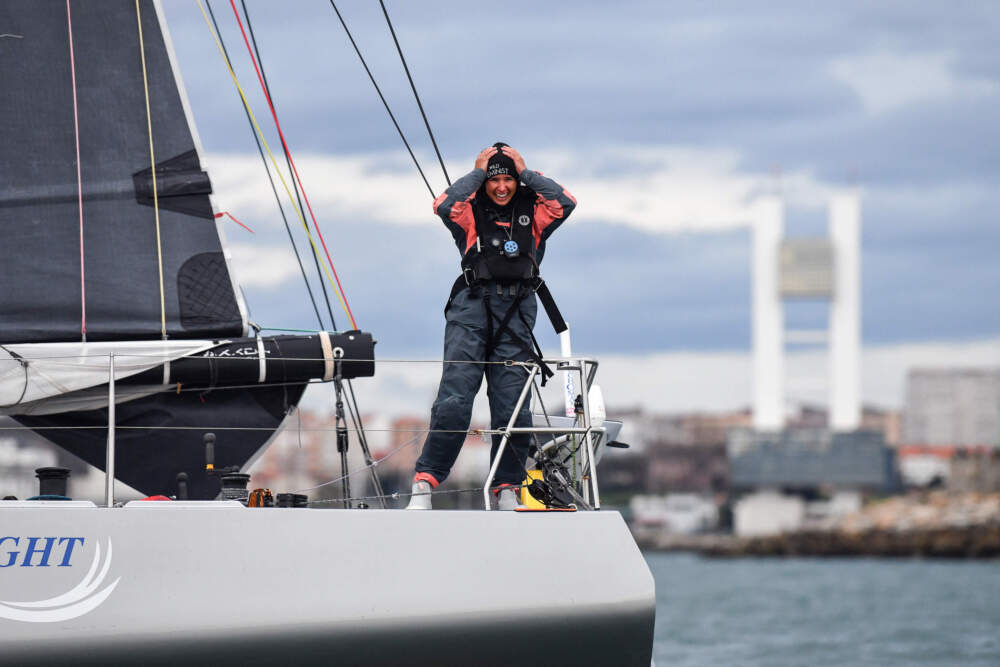
Fewer than 200 people have ever sailed solo non-stop around the world. Cole Brauer is the only American woman among them.
The 29-year-old completed the 30,000-mile journey last week when she stepped off her 40-foot sailboat, First Light, and onto dry land after 130 days at sea. Brauer was the only woman out of 16 boats that competed in the race, the Global Solo Challenge, this year. She finished the race, which began in late October, on March 7 in Spain.

9 questions with Cole Brauer
What is it like to walk on land after 130 days at sea?
"Everyone really thought that I was going to like trip or stumble and people were really concerned about me. My dad even kind of picked me off the boat and carried me for a second. But I think because I was exercising on the boat, I was doing things, I wasn't just sitting down below, and the boat is constantly moving quite quickly that I never got the vertigo type of feeling that you normally would get."
What was it like to see people, your family again? Did you laugh? Did you cry?
"I think I was the only person not crying on the dock. The entire crowd, my parents, my team, I got second place and even the first-place competitor when he handed me my trophy was even crying. I think I was the only one not crying. And I don't know if maybe it just hasn't hit me yet."
How did your boat hold up?
"My boat held up pretty well. I was a little disappointed in how she held up, but when I look at the other competitors and what it actually takes to go around the world, she did great. And I think maybe I'm just a perfectionist in that kind of way. I don't want things to break. I felt like we were going through things too quickly. The last couple of days my team and I have been dedicated to looking at what is broken and taking the whole boat apart."
What did break?
"Oh god, do you want the list? I think the majority was actually electrical. Saltwater is just horrible for electronics, and your electronics are waterproof with freshwater, not saltwater. The salt is just really good at corroding and killing everything."
Tell us about the route and what the hardest spot was for you?
"You leave from Acuña, Spain, and you travel south and then you navigate through the Canary Islands and Cape Verde, which is off of Africa. And then you go across the equator, there's a couple of islands off of Brazil. You go through those and then you take a left turn to go and start your Cape [of Good Hope] journey. To be honest, that whole area inside the Southern Ocean—you have the South Atlantic, the Indian Ocean and the Pacific Ocean, and each individual one is so different because of the currents, because of the wind, the waves, and how close each of these oceans is to the land. And so each have their own struggles. I think no sailor out there will disagree that the Southern Oceans are by far the most challenging."
You must have learned a lot about the weather, weather patterns, wind patterns.
"100%. I had a very good team behind me. My weather router, Chelsea, sent a 10-year historical analysis about the Southern Oceans to me about three weeks before the start of the race, so I read her entire booklet. She sends me where she thinks that the breeze is going to be coming from, and then I have to decide on what sails to use, and how big the sails should be that I'm going to use, and where I'm going to go. We talked every single day. My team was like, 'Okay, we trust that your eyes are seeing this firsthand and you're going to make the right decisions for how big the seas are and how windy it is.'"
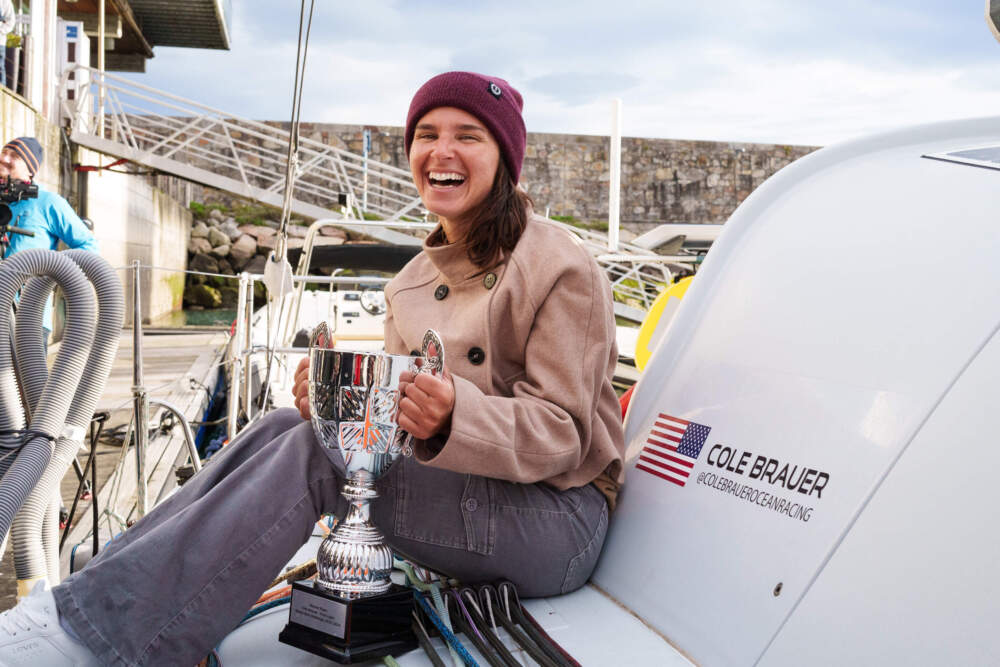
How did you stay on course?
"I, of course, have like an autopilot system that’s driving at all times, because the autopilot can drive perfectly 100% of the time, where I can drive perfectly for maybe 10 minutes. On the ocean, autopilots are 100% necessary and almost every boat has them. It's just not really possible to drive all night long and there's no place to just pull over and park. A lot of the technology is programmable, so you have a PC and you're constantly programming it for the specific conditions. And I'm not a video game geek, so I struggle with that, but everything has a manual. If you can read a manual, you can sail."
You’re on Instagram, and I read that you began with the goal of having maybe 10,000 people following you around the world. I think you're at about 500,000 followers now on Instagram. You were posting a lot during this trip. I understand some of your sponsors weren’t necessarily happy about that. Why did you decide to do it?
"I had it in my mind that if you wanted to make this important, people had to see it. You know, there's one thing to go around the world and there's another thing to actually show the world what you're doing, and show the sport that is so obscure and that people don't really know about. Exposing myself on to social media didn't seem like that crazy to me and to an older generation it did."
Are you hoping to inspire young people to try things, to sail, to do something adventurous?
"Yeah, of course. I have a protegé. I started working with her when she was 15, and I think she's now 17 going to be 18. She flew all the way from Connecticut to Spain just to see my finish. I look at her and, you know, her friends, and anyone else that I've spoken to about this and I’m at the forefront of this campaign, but it's the people behind me that have been lifting me up the entire time. My advice to anyone is keep those friends that really respect you and understand your dreams and want to be a part of it. Find the people that are willing to participate in your dreams and don't laugh at you or think that you're crazy, because when you actually get the opportunity, you want to have some people in your corner."
Julia Corcoran produced and edited this interview for broadcast with Todd Mundt . Corcoran also adapted it for the web.
This segment aired on March 14, 2024.

Scott Tong Co-Host, Here & Now Scott Tong joined Here & Now as a co-host in July 2021 after spending 16 years at Marketplace as Shanghai bureau chief and senior correspondent.

Julia Corcoran Producer, Here & Now Julia Corcoran is an associate producer for Here & Now.
More from Here & Now
Sailor Cole Brauer makes history as the first American woman to race solo around the world
Aboard her 40-foot racing boat First Light , 29-year-old Cole Brauer just became the first American woman to race nonstop around the world by herself.
The New York native pulled into A Coruña, Spain, on Thursday after a treacherous 30,000-mile journey that took 130 days.
She thanked a cheering crowd of family and fans who had been waiting for her on shore.
“This is really cool and so overwhelming in every sense of the word,” she exclaimed, before drinking Champagne from her trophy.
The 5-foot-2 powerhouse placed second out of 16 avid sailors who competed in the Global Solo Challenge, a circumnavigation race that started in A Coruña with participants from 10 countries. The first-of-its-kind event allowed a wide range of boats to set off in successive departures based on performance characteristics. Brauer started on Oct. 29, sailing down the west coast of Africa, over to Australia, and around the tip of South America before returning to Spain.
Brauer is the only woman and the youngest competitor in the event — something she hopes young girls in and out of the sport can draw inspiration from.
“It would be amazing if there was just one girl that saw me and said, ‘Oh, I can do that too,’” Brauer said of her history-making sail.
It’s a grueling race, and more than half of the competitors have dropped out so far. One struck something that caused his boat to flood, and another sailor had to abandon his ship after a mast broke as a severe storm was moving in.
The four-month journey is fraught with danger, including navigating the three “Great Capes” of Africa, Australia and South America. Rounding South America’s Cape Horn, where the Atlantic and Pacific Oceans meet, is often likened to climbing Mount Everest because of its perfect storm of hazards — a sharp rise in the ocean floor and whipping westerly winds push up massive waves. Combined with the frigid waters and stray icebergs, the area is known as a graveyard for ships, according to NASA. Brauer said she was “so unbelievably stoked” when she sailed past Cape Horn in January.
Marco Nannini, organizer of the Global Solo Challenge, said the comparison to scaling Mount Everest doesn’t capture the difficulty of the race. Sailing solo means not just being a skipper but a project manager — steering the boat, fixing equipment, understanding the weather and maintaining one’s physical health.
Nannini cited the relatively minuscule number of people who have sailed around the world solo — 186, according to the International Association of Cape Horners — as evidence of the challenges that competitors face. More than 6,000 people have climbed Mount Everest, according to High Adventure Expeditions .
Brauer stared down 30-foot waves that had enough force to throw her across the boat. In a scare caught on camera, she badly injured her rib near the halfway point of the event. At another point, her team in the U.S. directed Brauer to insert an IV into her own arm due to dehydration from vomiting and diarrhea.
She was able to stay in constant communication with members of her team, most of whom are based in New England, and keep herself entertained with Netflix and video calls with family through Starlink satellites. That’s also how Brauer was able to use Zoom to connect with NBC News for an interview, while she was sailing about 1,000 miles west of the Canary Islands.
While Brauer was technically alone on First Light, she had the company of 450,000 followers on Instagram, where she frequently got candid about life on an unforgiving sea while reflecting on her journey.
“It all makes it worth it when you come out here, you sit on the bow, and you see how beautiful it is,” she said in an Instagram video, before panning the camera to reveal the radiant sunrise.
Brauer grew up on Long Island but didn’t learn to sail until she went to college in Hawaii. She traded in her goal of becoming a doctor for life on the water. But she quickly learned making a career as a sailor is extremely difficult, with professional racers often hesitant to welcome a 100-pound young woman on their team.
Even when she was trying to find sponsors for the Global Solo Challenge, she said a lot of people “wouldn’t touch her with a 10-foot pole” because they saw her as a “liability.”
Brauer’s message to the skeptics and naysayers? “Watch me.”
“I push so much harder when someone’s like, ‘No, you can’t do that,’ or ‘You’re too small,’” Brauer explained.
“The biggest asset is your mental strength, not the physical one,” Nannini said. “Cole is showing everyone that.”
Brauer hopes to continue competing professionally and is already eyeing another around-the-world competition, but not before she gets her hands on a croissant and cappuccino.
“My mouth is watering just thinking about that.”
Emilie Ikeda is an NBC News correspondent.
Cole Brauer becomes first American woman to sail solo, nonstop around world

A joyful Cole Brauer returned in her boat Thursday to A Coruña, 130 days after sailing away from the Spanish port city.
Completing the epic voyage made the 29-year-old the first American woman to sail around the world nonstop, with no one else aboard. Brauer’s solo feat, which unfolded over approximately 30,000 miles, was also good for a second-place finish in rigorous Global Solo Challenge.
“Amazing finish!!!! So stoked!” Brauer wrote on Instagram. “Thank you to everyone that came together and made this process possible.”
Brauer provided regular updates on her voyage, which began Oct. 29, as her Instagram following burgeoned from less than 100,000 to almost half a million. Along the way, the East Hampton, N.Y., native shared battles with high winds, monstrous waves and maintenance issues on her Class 40 monohull, named “First Light.”
The 5-2, 100-pound sailor, who learned to sail at the University of Hawaii, posted clips of herself getting bruised ribs when suddenly flung across the interior of her boat and self-administering fluids intravenously to ward off dehydration. Her journey took her around the three great capes — Africa’s Cape of Good Hope, Australia’s Cape Leeuwin and South America’s treacherous Cape Horn — and through Point Nemo, an area in the Pacific Ocean so far from any land that the nearest humans are often orbiting overhead in the International Space Station.
View this post on Instagram A post shared by COLE BRAUER OCEAN RACING (@colebraueroceanracing)
According to race organizer Marco Nannini, over half of the 16 entrants in this installment of the event have had to retire before completing it. One passed a kidney stone at sea, per Nannini, before making landfall in New Zealand for medical assistance, and another was semi-submerged and out of contact for “24 very long hours prior to rescue” after a collision in the remote Pacific.
Brauer joins a group of fewer than 200 people known to have sailed solo around the world without stopping. The first, according to a list maintained by the International Association of Cape Horners , was England’s Robin Knox-Johnston in 1969.
The first woman to accomplish the feat, per Nannini, was Australia’s Kay Cottee in 1988. Brauer is the 18th.
“It was a long and emotional day,” Nannini wrote Thursday, “which started well before sunrise after a sleepless night monitoring Cole’s progress, meeting her at sea, watching her sail at First Light into A Coruna and celebrating her outstanding achievement. Well done Cole!”
Brauer was the youngest competitor in the Global Solo Challenge field — and the only woman. Of making her mark in a “fully male-dominated world,” as she put it in a recent interview with NBC , Brauer said, “I think that it takes a lot of strength to actually push and to strive into this industry, and I really want women to understand that it’s possible.”
“It would be amazing if there was just one other girl that saw me and said, ‘Oh, I can do that, too,’” she said .
She had lived a life of adventure. Then came the ultimate sailing race.
Last year, Brauer won the opening leg of the One-Two Yacht Race , which involved sailing solo from Rhode Island to Bermuda. All competitors picked up a second sailor for the return trip, and Brauer finished first again with teammate Catherine Chimney as they became the first all-female duo to win the race overall.
Each leg of that competition took approximately three days, barely a toe in the water compared to the duration of Brauer’s just-completed circumnavigation, but the first three days of the Global Solo Challenge were some of the hardest for her. She endured a “ pretty rough, rough, rough start ” making her way around the Spanish coast after departing A Coruña, an experience she described on Instagram as a “trial by fire.”
The second day of the event began with Brauer vomiting — “I’ve never had seasickness before in my life,” she told her followers, adding that she may have suffered from food poisoning — and shortly thereafter she gave herself the IV on the advice of her medical team.
Brauer shared plenty of posts in her usually upbeat demeanor, but a Dec. 8 video found her “ angry that things keep going wrong” with her boat. “Right now, I have been feeling just broken,” Brauer said with emotion. But she was smiling at the camera the next day while engaging in some “ self care ” as some technical issues got ironed out.
By Christmas Eve , Brauer was past Cape Leeuwin, close to the halfway point of the journey as she began the long, challenging stretch across the Pacific. After dodging some strong weather systems and enduring others, she passed Cape Horn and was finally back in the Atlantic in late January. Of course, there were still some “ horrendous conditions ” to deal with, but Brauer also shared excitement about the media coverage her exploits were attracting.
“So excited to move sailing into the mainstream!” Brauer wrote on Instagram late last month. “For far too long sailing and racing has been in the shadows maybe partially due to its attempts to keep its ‘traditions’ but those ‘traditions’ have also pushed really amazing sailors out of the industry due to burn out rates and unnecessary exclusivity. This hasn’t been easy one bit but it makes it all worth it to see that we are taking this industry from the dark and bringing it into the light.”
After making her long-awaited return to dry land, she told NBC , “It was really emotional, because I see my parents, I see my friends, my family — I see everyone — and this dream has become a reality.”
- Harvard offers a lot to star guard Malik Mack. Except big NIL money. 2 hours ago Harvard offers a lot to star guard Malik Mack. Except big NIL money. 2 hours ago
- Gonzaga is no stranger to March, even when it’s not quite Gonzaga 2 hours ago Gonzaga is no stranger to March, even when it’s not quite Gonzaga 2 hours ago
- NFL free agency: Who got better, who got worse, and what questions remain? 1 hour ago NFL free agency: Who got better, who got worse, and what questions remain? 1 hour ago

- Yachting World
- Digital Edition

How to cross the Atlantic in short hops
- October 7, 2021
If a non-stop eastbound Atlantic crossing seems daunting, there may be another option, which offers shorter periods at sea and spectacular scenery, but brings its own challenges...

An Atlantic crossing is – rightly – considered a bit of an epic. An east-bound crossing, often even more so. But by following the seafarers of old, on what is pleasingly known as the Viking Route , it’s possible to cross from tropical Florida or metropolitan New York to Europe with less than a week at sea at any one time.
That’s not to say it’s an easy option. A high latitudes voyage into the North Atlantic demands respect and serious preparation to sail in remote areas with increased risk of severe weather and sea ice. But the rewards can be spectacular.
Alberto Duhau sailed his Hylas 63 Shaima from Florida to the Mediterranean one summer, by heading north along the east coast of the US, across the North Atlantic via Newfoundland, Greenland and Iceland, then south to Europe via the Faroe Islands. Here’s how he did it:

1 Newfoundland to southern Greenland
During July, high pressure is typically centred just south-west/west of the Azores with ridging extending south-west/west towards Bermuda. There is a weak high over Greenland, with low pressure generally over north-east Canada (Baffin Island to northern Quebec) and near Iceland.
To the north of the Azores high, the prevailing winds are west/south-west for much of the way to Iceland. Wind is usually stronger south of the rhumbline, and lighter to the north. July offers the lowest chance of gales, but occasionally stronger lows develop and move east/south-east from eastern Canada.
2 Greenland to Iceland
For this passage the main concern is the north-easterly wind near Greenland’s Cape Farewell. If the Greenland high pressure system is stronger than normal, beware of north-easterly winds along the south Greenland coast of 25-30 knots plus.
Article continues below…
Expect light conditions heading east toward Iceland. If south of the rhumbline, there is greater chance of stronger westerly/south-westerly winds, while a northerly route is more likely to encounter north-easterly/easterly headwinds.

Packing up the sails, Northern Iceland
3 Around Iceland and to Faroes
Circumnavigating Iceland at the end of July and beginning of August is the optimum timing with the smallest threat of gales, but you may have to wait out bad winds for a day or two for a window.
The roughest weather is associated with low pressure passing to the west, north-west, or west, which correspondingly means the strongest winds are south-westerly, westerly, and north-westerly.
Avoiding North Atlantic storms and ice
Alberto Duhau enlisted the advice of expert meteorologists in advance of his north Atlantic trip. He knew the voyage was possible in good conditions, but wanted a second opinion regarding timings.
Research revealed that the region’s quietest weather historically occurs between mid-July and the first 10 days of August. However, settled conditions can run from late June to the end of August. Autumn develops earlier the farther north you are, so it is generally a good plan to turn south by the second half of August.
Duhau also contacted the well-known expedition support High Latitudes for help with ice routing between Newfoundland and Iceland. Founder and experienced pilot Magnus Day joined the crew for this part of the cruise.
“Ice is possible anywhere from Nova Scotia to about 150 miles south and east of Cape Farewell,” Day warns. “All ice should be regarded as dangerous to small vessels.”
Ice charts are available from the Canadian Ice Service ( ice-glaces.ec.gc.ca ) and the Danish Maritime Authority ( dma.dk ) and are useful as a guide, but must not be relied upon. Radar is also a useful tool, but it may not pick up even large pieces of ice in certain conditions.
Ice in the Labrador Sea will usually be thicker along the Newfoundland and Greenland coasts. Commanders’ Weather recommends heading due east until around 45°W, then turning north.
Magnus Day broadly concurs. “A wise tactic to lessen the chances of encountering ice is to head square offshore until outside the reported ice zone, then more or less parallel to the axis of the Labrador Sea until adjacent to your destination, before turning in square to the shore again.” He recommends motoring if the wind is light.
Day’s other top tips include:
- Have one or more crew outside on deck paying close attention for ice at ALL times.
- Ideally have two crew rotating on every watch – one on deck keeping a visual lookout while the other keeps a radar watch and makes the coffee etc. Roles should be swapped as regularly as every 15 minutes to help maintain levels of alertness.
- Ask passing vessels if they have seen any ice locally. Likewise, when in port talk to locals and ask them what they’ve seen recently and if there are areas locally which collect ice.
- Crew need to be dressed to stand outside in freezing temperatures with wind and waves coming over the deck for long periods of time. Think about how you can create shelter for them on deck.
- Never drop your guard. It only takes one piece of ice to bash a hole in your hull as you fall off a wave.
Expert advice for ice regions
Commanders’ Weather has been advising sailors about optimum weather routing for over 25 years. Their expert meteorologists have supplied forecasts for cruisers and racers, including the SailGP circuit, Olympic sailing teams and Comanche ’s 2016 Atlantic record. See commandersweather.com
As well as pilotage, High Latitudes has the expertise to plan itineraries in both polar regions, secure the necessary environmental permits, offer logistical support and work on modifications to suit a yacht for ice. See highlatitudes.com
If you enjoyed this….
Yachting World is the world’s leading magazine for bluewater cruisers and offshore sailors. Every month we have inspirational adventures and practical features to help you realise your sailing dreams. Build your knowledge with a subscription delivered to your door. See our latest offers and save at least 30% off the cover price.

IMAGES
VIDEO
COMMENTS
A 35-footer might take 25-28 days to sail across the Atlantic from the Canaries to the West Indies. Obviously, the longer and faster your boat is, the more stowage and water tankage you will have for less time at sea. You might also ask yourself which parts of the adventure are the most valuable to you.
So, the default options are: go south for comfort and safety; go north for speed. Most boats take a more middle route, depending on the forecast. Chris Tibbs is a meteorologist and sailor with ...
The Atlantic crossing refers to the journey of sailing across the Atlantic Ocean from one continent to another. It is a significant achievement for sailors and offers a unique experience of being surrounded by vast open waters for an extended period. ... The duration of the Atlantic crossing varies based on factors such as boat size, type, crew ...
According to Jimmy Cornell, a well-known sailor and circumnavigator that has made his own research on the subject, Las Palmas is one of the biggest ports of departure for sailboats crossing the Atlantic. Around 75'% of the sailboats that arrive in Las Palmas on the Canary Islands will depart for an Ocean crossing.
Sailing boat: strong emotions and contact with the sea. The sailboat embodies the essence of the traditional art of sailing. Atlantic crossings with a sailboat offer a more authentic experience, bringing the crew closer to the heartbeat of the ocean. Sailing on a sailboat compared to a catamaran requires more technical skill and a thorough ...
Numerically, the most common yachts for sailing across the Atlantic are ordinary production cruisers with standard kit, usually with upgrades of safety and power generation equipment. The happy ...
12:14. Increase the means of generating electricity with a diesel generator, larger alternator, solar panels and/or a towed turbine and look at means of making savings, such as fitting LED lights ...
Celebrating the Accomplishment. - Celebrating the Accomplishment. - After sailing across the Atlantic, it is important to celebrate the accomplishment. - Organize a gathering and invite friends and family to share in the occasion. - Plan a special dinner or party to commemorate crossing the challenging body of water.
3. Know the bearings. To be ready to expect the unexpected, careful investigation and preparation is essential for a happy and safe ocean passage. Learn about the Atlantic Ocean passage, seasons, distance, destinations, weather, costs, and tasks involved. This will help you find a ride at the right time and place.
Discover the challenges and beauty of sailing across the Atlantic. Learn about weather, when to go, and how to prepare for the voyage. Kraken Travel. Get in touch to plan your adventure +44 2080 128 209. ... Join an Atlantic 49 expedition yacht for an unforgettable, 48 day & 4500 NM, sailing trip from Cape Town to St. Helena. One Way or Return ...
Sail Across the Atlantic Ocean & Transatlantic Voyages: Expert Guide. ... Heading offshore is a different level of adventure from coastal sailing. Yachts that may be perfect for a season cruising in the Mediterranean can be inversely suitable for crossing an ocean and ocean sailing. Any yacht will happily make the crossing in the right ...
A shoestring budget is fine. One of the enduring myths surrounding the Atlantic circuit is that it can be undertaken on a shoestring budget, subsisting on freshly caught wild lobsters while spending life on the hook. While the concept is well grounded in historical precedents, it's crucial to dispel this notion for modern-day cruisers.
4 September, 2019. The best time to cross the Atlantic by sailboat from Europe or Africa to the American continent is between the months of October to January. On those dates, hundreds of boats are preparing to carry out an adventure that will take them between 15 and 30 days, depending on the capabilities of the ship and the route they intend ...
Sail South Atlantic Falkland Islands to Cape Town via South Georgia & Tristan da Cunha. Beneteau 40 or Harmony 52 yachts sailing Caribbean to UK. Atlantic Circuit Sail Lisbon to Suriname tall ship. Check all Atlantic ocean crossings here or email Larissa on [email protected].
The digital nomad lifestyle is an antidote to the traditional nine to five. As a result, family entries for the Atlantic Rally for Cruisers have increased and in November 2022, a total of 16 family boats with 24 children crossed the Atlantic with the rally. Marko Agthe, an environmental engineer from the landlocked town of Mücheln in the ...
Have you ever thought about sailing across the Atlantic? Two or three weeks in the deep blue ocean between Europe and America. ... The season to cross the Atlantic by boat from Europe to America begins when winter begins in Europe, which roughly coincides with the hurricane season in the Atlantic. Crowds of ships and navigators depart each year ...
The unexpected joys of sailing across the Atlantic. 15 August 2023 • Written by Caroline White. Three owners joined their superyachts to cross the Atlantic and found more than they expected in the vastness of the ocean, they tell Caroline White. Crossing oceans is a necessity if you want to get your yacht to the good stuff on either side.
Sailing across the Atlantic in the tradewinds - or back to Europe - is one of the biggest feats and adventures in sailing. In most cases, the crossing is the culmination of years of planning ...
The story of 106m Black Pearl's long-awaited sail across the Atlantic. 22 September 2023 • Written by Holly Overton. ... When she was finally delivered in 2018, she was the largest sailing yacht in the world and by far the most technologically advanced. She was built to cross oceans but, up until last year, had barely strayed from Europe. ...
Typically, sailing across the Atlantic can take anywhere from a few weeks to several months. The fastest recorded time for crossing the Atlantic stands at just over 5 days, accomplished by high-performance sailing yachts. The average duration for most sailors falls between 2 to 4 weeks.
Conclusion. There are many ways to cross the Atlantic by motor yacht, but there are three main routes that are most popular. The first route is from the Canary Islands to the Caribbean. This route is popular because it offers good weather and sailing conditions. The second route is from the Azores to Bermuda.
Capt. Jen of Schooner WOODWIND returns to the podcast after having just sailed with Andy aboard FALKEN on the 2,100 mile passage across the Atlantic! Jen and Andy reflect on Jen's first big ocean crossing and what it was like to leave the wintry Chesapeake Bay for tropical Tradewind sailing. They al…
On Thursday, Cole Brauer made history, becoming the first American woman to sail solo nonstop around the world. The 29-year-old from Long Island, New York, celebrated at the finish line in Spain ...
Soldiers aboard the USAV SP4 James A. Loux (LSV-6) prepare to depart from Fort Eustis, Va., for a mission to build a pier off Gaza. March 12, 2024. USNI News Photo Fort Eustis, Va. - More pieces ...
She sailed her way into the history books. A 29-year-old skipper from New York has become the first US woman to sail solo around the world. Cole Brauer, from Long Island, tearfully reunited with ...
Many people planning to sail across the Atlantic plan their adventure three, four or even five years ahead of time, but others manage to do it in a much shorter timespan. After all, many things ...
She finished the 30,000-mile, 130-day journey in her 40-foot sailboat last week in Spain.
Aboard her 40-foot racing boat First Light, 29-year-old Cole Brauer just became the first American woman to race nonstop around the world by herself. ... where the Atlantic and Pacific Oceans meet ...
The 5-2, 100-pound sailor, who learned to sail at the University of Hawaii, posted clips of herself getting bruised ribs when suddenly flung across the interior of her boat and self-administering ...
Best family yacht: our pick of the best yachts for sailing with the family 2020 Vendée Globe preview: Pip Hare and Paul Larsen's guide to the fleet Spirit 111: This sailing art gallery is one ...